Impacts of Hazardous Waste Management on Environment and Health
VerifiedAdded on 2023/06/07
|22
|5901
|229
AI Summary
The report examines the impacts of hazardous waste management on the environment and human health. It discusses the impacts of different hazardous materials such as Asbestos, Waste Oil, Alkali Wastes, Lead Waste, Clinical Waste, Contaminated Soils, Spent pot liner waste, Contaminated bio-solids, non-toxic salts, Persistent organic pollutants on the human health and also on the environment. Identification of the impacts and the possible measures can help in the better understanding of the hazardous waste management.
Contribute Materials
Your contribution can guide someone’s learning journey. Share your
documents today.
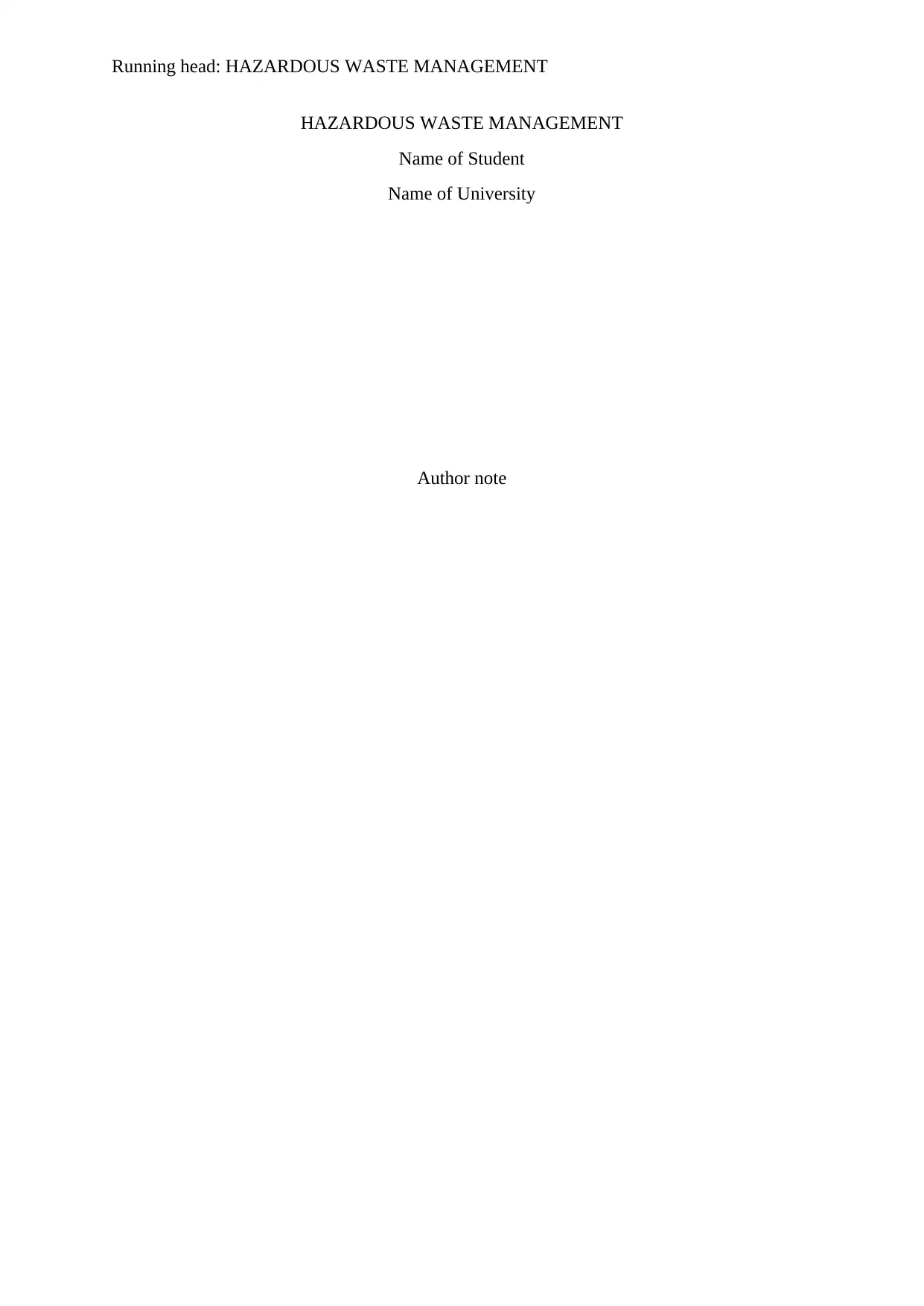
Running head: HAZARDOUS WASTE MANAGEMENT
HAZARDOUS WASTE MANAGEMENT
Name of Student
Name of University
Author note
HAZARDOUS WASTE MANAGEMENT
Name of Student
Name of University
Author note
Secure Best Marks with AI Grader
Need help grading? Try our AI Grader for instant feedback on your assignments.
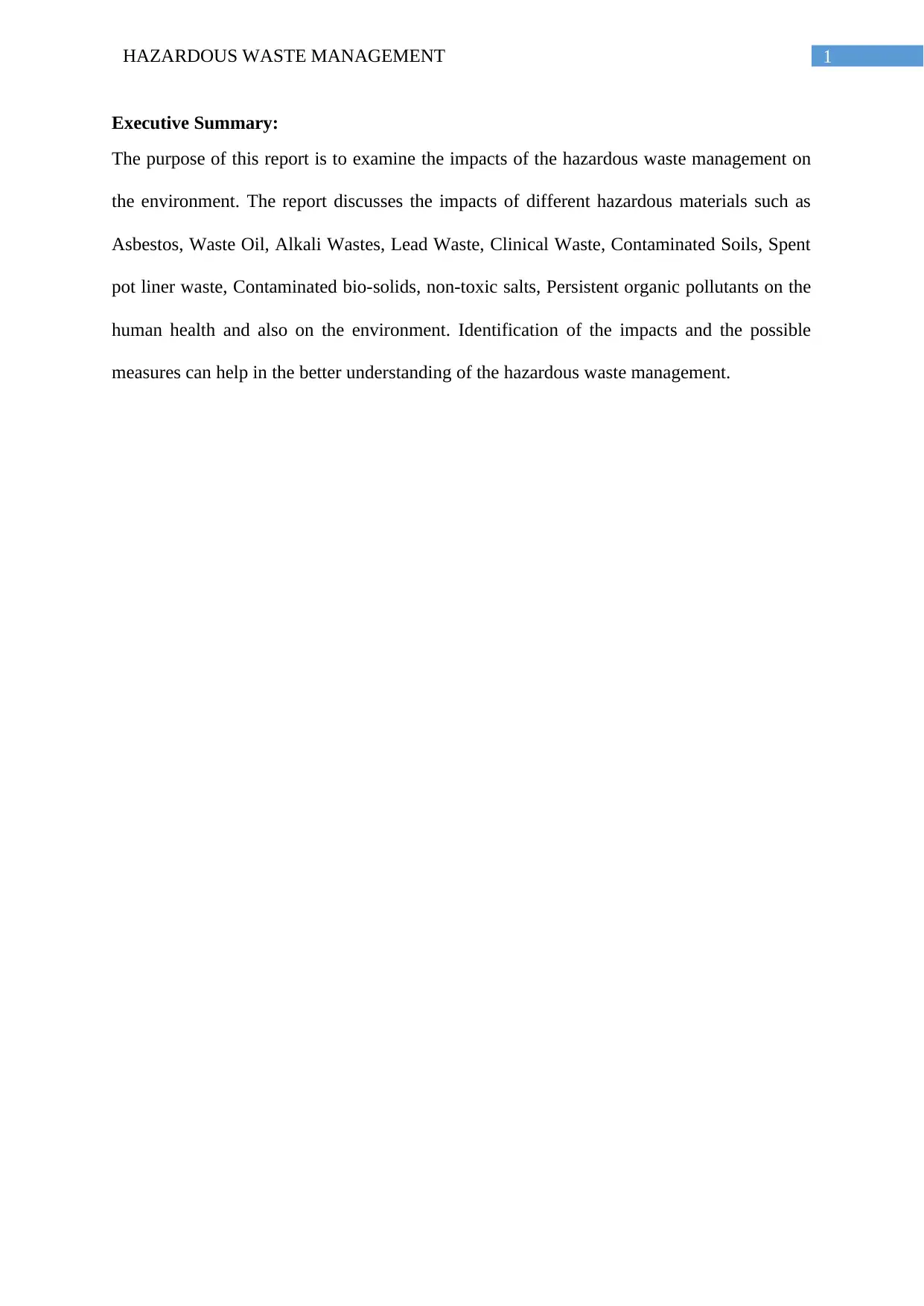
1HAZARDOUS WASTE MANAGEMENT
Executive Summary:
The purpose of this report is to examine the impacts of the hazardous waste management on
the environment. The report discusses the impacts of different hazardous materials such as
Asbestos, Waste Oil, Alkali Wastes, Lead Waste, Clinical Waste, Contaminated Soils, Spent
pot liner waste, Contaminated bio-solids, non-toxic salts, Persistent organic pollutants on the
human health and also on the environment. Identification of the impacts and the possible
measures can help in the better understanding of the hazardous waste management.
Executive Summary:
The purpose of this report is to examine the impacts of the hazardous waste management on
the environment. The report discusses the impacts of different hazardous materials such as
Asbestos, Waste Oil, Alkali Wastes, Lead Waste, Clinical Waste, Contaminated Soils, Spent
pot liner waste, Contaminated bio-solids, non-toxic salts, Persistent organic pollutants on the
human health and also on the environment. Identification of the impacts and the possible
measures can help in the better understanding of the hazardous waste management.
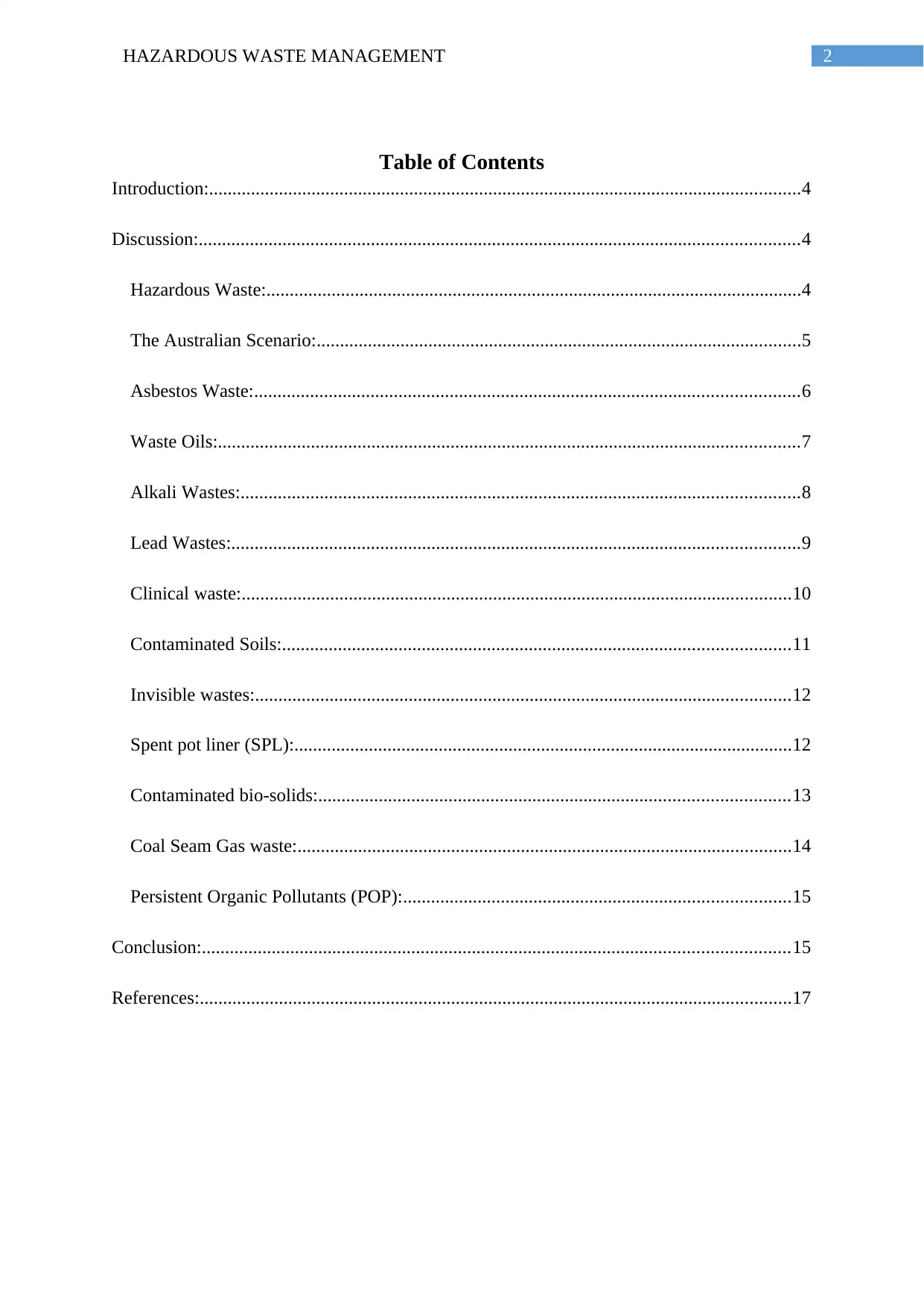
2HAZARDOUS WASTE MANAGEMENT
Table of Contents
Introduction:...............................................................................................................................4
Discussion:.................................................................................................................................4
Hazardous Waste:...................................................................................................................4
The Australian Scenario:........................................................................................................5
Asbestos Waste:.....................................................................................................................6
Waste Oils:.............................................................................................................................7
Alkali Wastes:........................................................................................................................8
Lead Wastes:..........................................................................................................................9
Clinical waste:......................................................................................................................10
Contaminated Soils:.............................................................................................................11
Invisible wastes:...................................................................................................................12
Spent pot liner (SPL):...........................................................................................................12
Contaminated bio-solids:.....................................................................................................13
Coal Seam Gas waste:..........................................................................................................14
Persistent Organic Pollutants (POP):...................................................................................15
Conclusion:..............................................................................................................................15
References:...............................................................................................................................17
Table of Contents
Introduction:...............................................................................................................................4
Discussion:.................................................................................................................................4
Hazardous Waste:...................................................................................................................4
The Australian Scenario:........................................................................................................5
Asbestos Waste:.....................................................................................................................6
Waste Oils:.............................................................................................................................7
Alkali Wastes:........................................................................................................................8
Lead Wastes:..........................................................................................................................9
Clinical waste:......................................................................................................................10
Contaminated Soils:.............................................................................................................11
Invisible wastes:...................................................................................................................12
Spent pot liner (SPL):...........................................................................................................12
Contaminated bio-solids:.....................................................................................................13
Coal Seam Gas waste:..........................................................................................................14
Persistent Organic Pollutants (POP):...................................................................................15
Conclusion:..............................................................................................................................15
References:...............................................................................................................................17

3HAZARDOUS WASTE MANAGEMENT
Introduction:
The modern day globalization and industrial advances has promised the world a
technologically advanced future. The improvements in the several factors of commodities and
services look forward to make life easier for the modern day people. However, it has to be
kept in mind that every benefit comes with a cost and so does all the technological global
advancements. Non-sustainable use of different resources to meet the demands of the ever-
growing population has led to the industrial sector and other sectors to create tons of
hazardous waste (Yang, 2017). These leftover products have no use in the later phases and
are just ready to be dumped. Improper dumping of hazardous wastes have been affecting the
world since the very advent of the industrial revolution. Very recently, the different global
environmental forums and the different governments of the world have realized the negative
impacts these hazardous wastes can do to the society. It is important to monitor the impact of
these hazardous wastes of the both the health of the society and the environment. These
monitoring can further help to identify the primary measures that should be taken by the
governments to check and control the impact of the hazardous waste (Hoornweg & Bhada-
Tata, 2012). In case of Australia, the Department of Environment has been actively trying to
monitor the environmental impact of the hazardous wastes so as check and control their
effects in the future for the benefits of the environment and health of the society. This
discussion highlights the key aspects of the environmental and health impacts of the
hazardous waste and how deeply they have been harming the nature as well as the human
health.
Introduction:
The modern day globalization and industrial advances has promised the world a
technologically advanced future. The improvements in the several factors of commodities and
services look forward to make life easier for the modern day people. However, it has to be
kept in mind that every benefit comes with a cost and so does all the technological global
advancements. Non-sustainable use of different resources to meet the demands of the ever-
growing population has led to the industrial sector and other sectors to create tons of
hazardous waste (Yang, 2017). These leftover products have no use in the later phases and
are just ready to be dumped. Improper dumping of hazardous wastes have been affecting the
world since the very advent of the industrial revolution. Very recently, the different global
environmental forums and the different governments of the world have realized the negative
impacts these hazardous wastes can do to the society. It is important to monitor the impact of
these hazardous wastes of the both the health of the society and the environment. These
monitoring can further help to identify the primary measures that should be taken by the
governments to check and control the impact of the hazardous waste (Hoornweg & Bhada-
Tata, 2012). In case of Australia, the Department of Environment has been actively trying to
monitor the environmental impact of the hazardous wastes so as check and control their
effects in the future for the benefits of the environment and health of the society. This
discussion highlights the key aspects of the environmental and health impacts of the
hazardous waste and how deeply they have been harming the nature as well as the human
health.
Secure Best Marks with AI Grader
Need help grading? Try our AI Grader for instant feedback on your assignments.
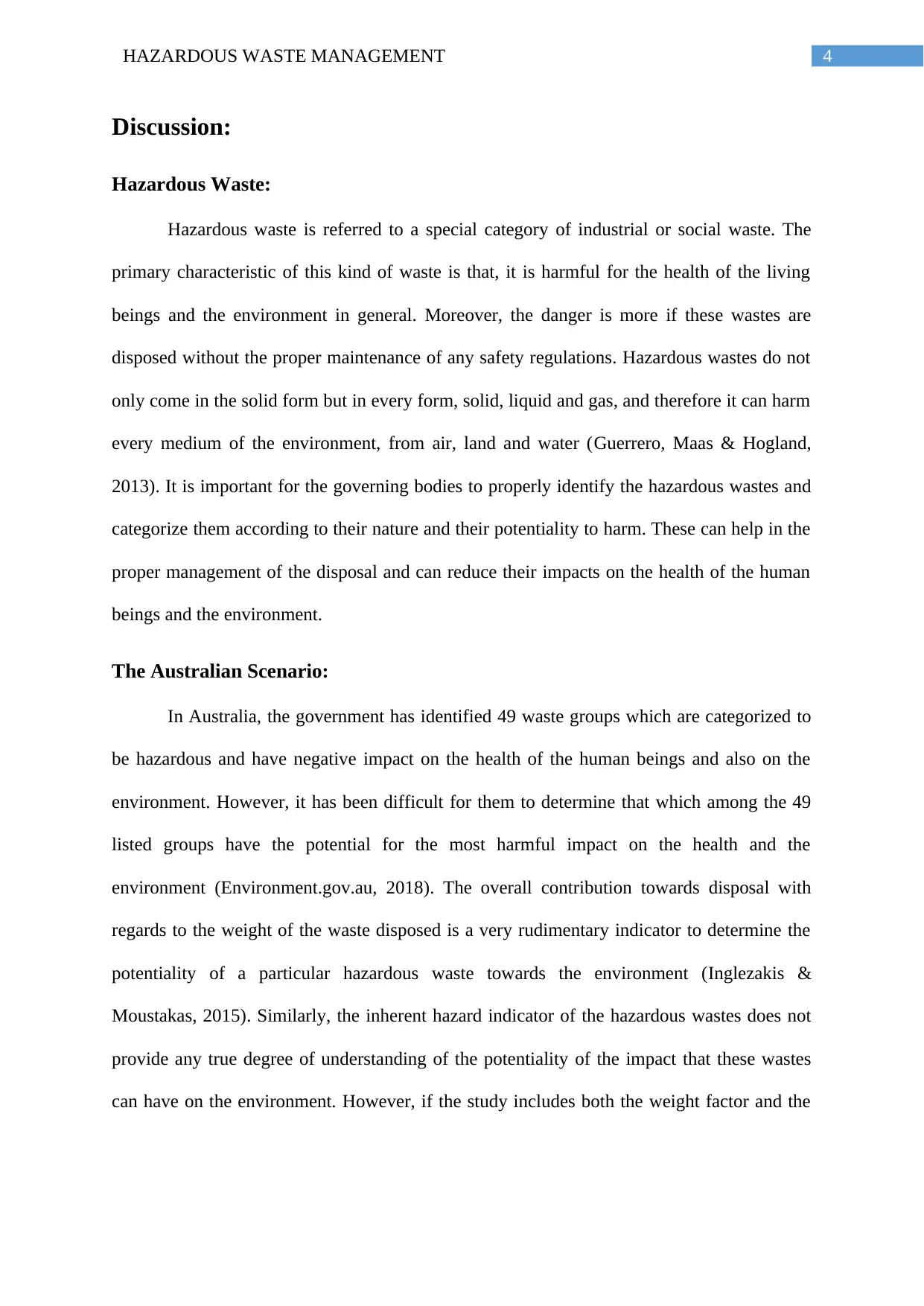
4HAZARDOUS WASTE MANAGEMENT
Discussion:
Hazardous Waste:
Hazardous waste is referred to a special category of industrial or social waste. The
primary characteristic of this kind of waste is that, it is harmful for the health of the living
beings and the environment in general. Moreover, the danger is more if these wastes are
disposed without the proper maintenance of any safety regulations. Hazardous wastes do not
only come in the solid form but in every form, solid, liquid and gas, and therefore it can harm
every medium of the environment, from air, land and water (Guerrero, Maas & Hogland,
2013). It is important for the governing bodies to properly identify the hazardous wastes and
categorize them according to their nature and their potentiality to harm. These can help in the
proper management of the disposal and can reduce their impacts on the health of the human
beings and the environment.
The Australian Scenario:
In Australia, the government has identified 49 waste groups which are categorized to
be hazardous and have negative impact on the health of the human beings and also on the
environment. However, it has been difficult for them to determine that which among the 49
listed groups have the potential for the most harmful impact on the health and the
environment (Environment.gov.au, 2018). The overall contribution towards disposal with
regards to the weight of the waste disposed is a very rudimentary indicator to determine the
potentiality of a particular hazardous waste towards the environment (Inglezakis &
Moustakas, 2015). Similarly, the inherent hazard indicator of the hazardous wastes does not
provide any true degree of understanding of the potentiality of the impact that these wastes
can have on the environment. However, if the study includes both the weight factor and the
Discussion:
Hazardous Waste:
Hazardous waste is referred to a special category of industrial or social waste. The
primary characteristic of this kind of waste is that, it is harmful for the health of the living
beings and the environment in general. Moreover, the danger is more if these wastes are
disposed without the proper maintenance of any safety regulations. Hazardous wastes do not
only come in the solid form but in every form, solid, liquid and gas, and therefore it can harm
every medium of the environment, from air, land and water (Guerrero, Maas & Hogland,
2013). It is important for the governing bodies to properly identify the hazardous wastes and
categorize them according to their nature and their potentiality to harm. These can help in the
proper management of the disposal and can reduce their impacts on the health of the human
beings and the environment.
The Australian Scenario:
In Australia, the government has identified 49 waste groups which are categorized to
be hazardous and have negative impact on the health of the human beings and also on the
environment. However, it has been difficult for them to determine that which among the 49
listed groups have the potential for the most harmful impact on the health and the
environment (Environment.gov.au, 2018). The overall contribution towards disposal with
regards to the weight of the waste disposed is a very rudimentary indicator to determine the
potentiality of a particular hazardous waste towards the environment (Inglezakis &
Moustakas, 2015). Similarly, the inherent hazard indicator of the hazardous wastes does not
provide any true degree of understanding of the potentiality of the impact that these wastes
can have on the environment. However, if the study includes both the weight factor and the

5HAZARDOUS WASTE MANAGEMENT
hazard index, it is possible to relate them accordingly and identify the key risks that can done
by the hazardous wastes.
Figure 1: Graph representing the amount of hazardous wastes in different Australian
provinces. (Source: Department of Environment and Energy, Australia)
In the study of the hazardous wastes in the Australian scenario, it has been reported
that of all the wastes listed in the category, the primary characteristics of most impactful
hazards can be identified in the top 10-12 category of the wastes. These hazards include
various biohazards caused from clinical and similar wastes. Some of the other types of
hazards are caused due to chromium poisoning which comes mainly from the preserves used
for preserving wood. These have a high impact on the environment as well as the human
health. Moreover, waste products from pesticides, furans, dioxides, PCBs and compounds
(Van der Sloot & Kosson, 2012). Shortlisting some of the most harmful wastes with regards
to the volume and the hazard index are Asbestos, Waste Oil, Alkali Wastes, Lead Waste,
Clinical Waste, Contaminated Soils, Spent pot liner waste, Contaminated bio-solids, non-
toxic salts, Persistent organic pollutants.
Asbestos Waste:
The asbestos waste is one of the primary hazardous waste materials which consist of
both the building material asbestos and the contaminated soil specimen which consists of
hazard index, it is possible to relate them accordingly and identify the key risks that can done
by the hazardous wastes.
Figure 1: Graph representing the amount of hazardous wastes in different Australian
provinces. (Source: Department of Environment and Energy, Australia)
In the study of the hazardous wastes in the Australian scenario, it has been reported
that of all the wastes listed in the category, the primary characteristics of most impactful
hazards can be identified in the top 10-12 category of the wastes. These hazards include
various biohazards caused from clinical and similar wastes. Some of the other types of
hazards are caused due to chromium poisoning which comes mainly from the preserves used
for preserving wood. These have a high impact on the environment as well as the human
health. Moreover, waste products from pesticides, furans, dioxides, PCBs and compounds
(Van der Sloot & Kosson, 2012). Shortlisting some of the most harmful wastes with regards
to the volume and the hazard index are Asbestos, Waste Oil, Alkali Wastes, Lead Waste,
Clinical Waste, Contaminated Soils, Spent pot liner waste, Contaminated bio-solids, non-
toxic salts, Persistent organic pollutants.
Asbestos Waste:
The asbestos waste is one of the primary hazardous waste materials which consist of
both the building material asbestos and the contaminated soil specimen which consists of
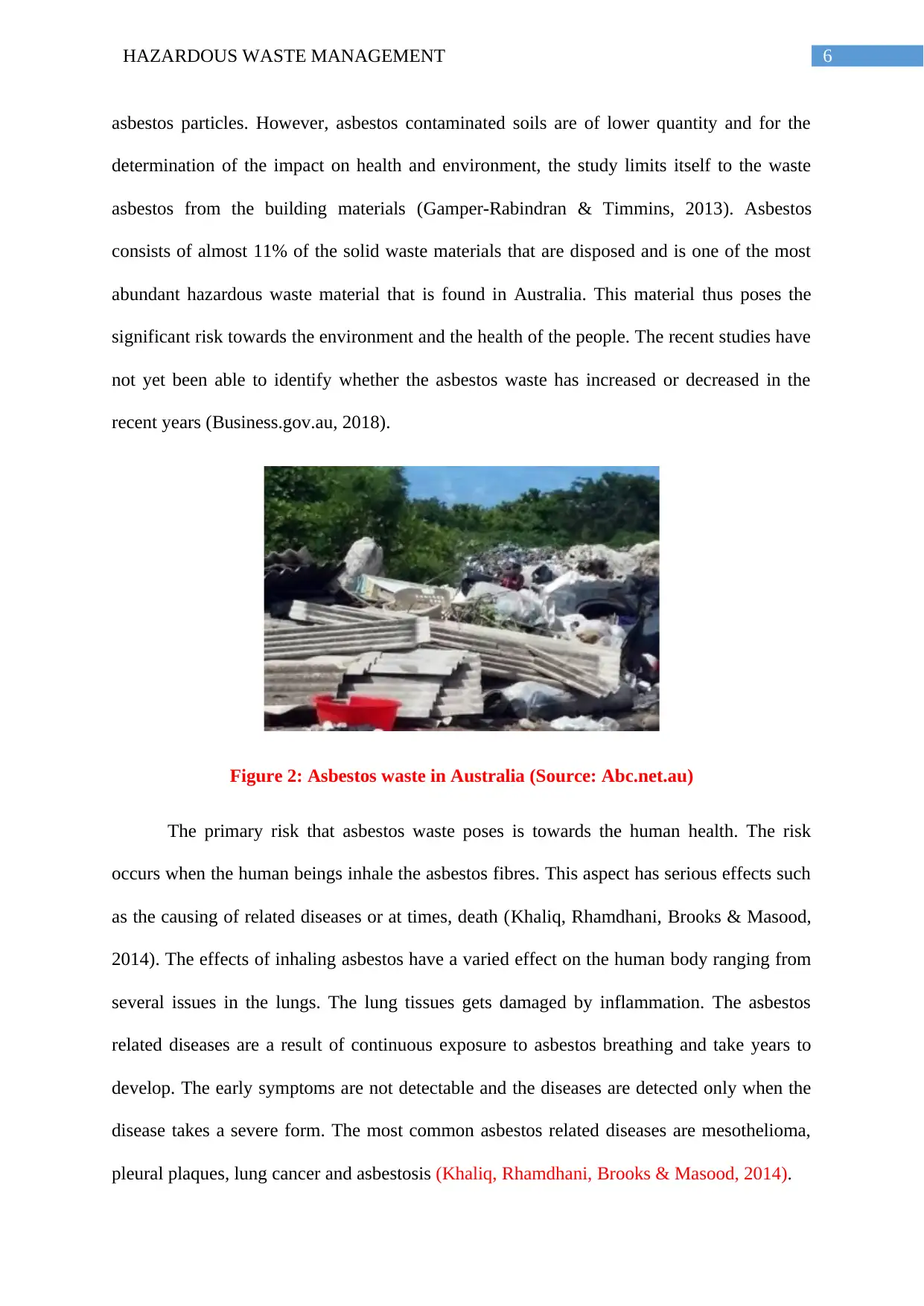
6HAZARDOUS WASTE MANAGEMENT
asbestos particles. However, asbestos contaminated soils are of lower quantity and for the
determination of the impact on health and environment, the study limits itself to the waste
asbestos from the building materials (Gamper-Rabindran & Timmins, 2013). Asbestos
consists of almost 11% of the solid waste materials that are disposed and is one of the most
abundant hazardous waste material that is found in Australia. This material thus poses the
significant risk towards the environment and the health of the people. The recent studies have
not yet been able to identify whether the asbestos waste has increased or decreased in the
recent years (Business.gov.au, 2018).
Figure 2: Asbestos waste in Australia (Source: Abc.net.au)
The primary risk that asbestos waste poses is towards the human health. The risk
occurs when the human beings inhale the asbestos fibres. This aspect has serious effects such
as the causing of related diseases or at times, death (Khaliq, Rhamdhani, Brooks & Masood,
2014). The effects of inhaling asbestos have a varied effect on the human body ranging from
several issues in the lungs. The lung tissues gets damaged by inflammation. The asbestos
related diseases are a result of continuous exposure to asbestos breathing and take years to
develop. The early symptoms are not detectable and the diseases are detected only when the
disease takes a severe form. The most common asbestos related diseases are mesothelioma,
pleural plaques, lung cancer and asbestosis (Khaliq, Rhamdhani, Brooks & Masood, 2014).
asbestos particles. However, asbestos contaminated soils are of lower quantity and for the
determination of the impact on health and environment, the study limits itself to the waste
asbestos from the building materials (Gamper-Rabindran & Timmins, 2013). Asbestos
consists of almost 11% of the solid waste materials that are disposed and is one of the most
abundant hazardous waste material that is found in Australia. This material thus poses the
significant risk towards the environment and the health of the people. The recent studies have
not yet been able to identify whether the asbestos waste has increased or decreased in the
recent years (Business.gov.au, 2018).
Figure 2: Asbestos waste in Australia (Source: Abc.net.au)
The primary risk that asbestos waste poses is towards the human health. The risk
occurs when the human beings inhale the asbestos fibres. This aspect has serious effects such
as the causing of related diseases or at times, death (Khaliq, Rhamdhani, Brooks & Masood,
2014). The effects of inhaling asbestos have a varied effect on the human body ranging from
several issues in the lungs. The lung tissues gets damaged by inflammation. The asbestos
related diseases are a result of continuous exposure to asbestos breathing and take years to
develop. The early symptoms are not detectable and the diseases are detected only when the
disease takes a severe form. The most common asbestos related diseases are mesothelioma,
pleural plaques, lung cancer and asbestosis (Khaliq, Rhamdhani, Brooks & Masood, 2014).
Paraphrase This Document
Need a fresh take? Get an instant paraphrase of this document with our AI Paraphraser
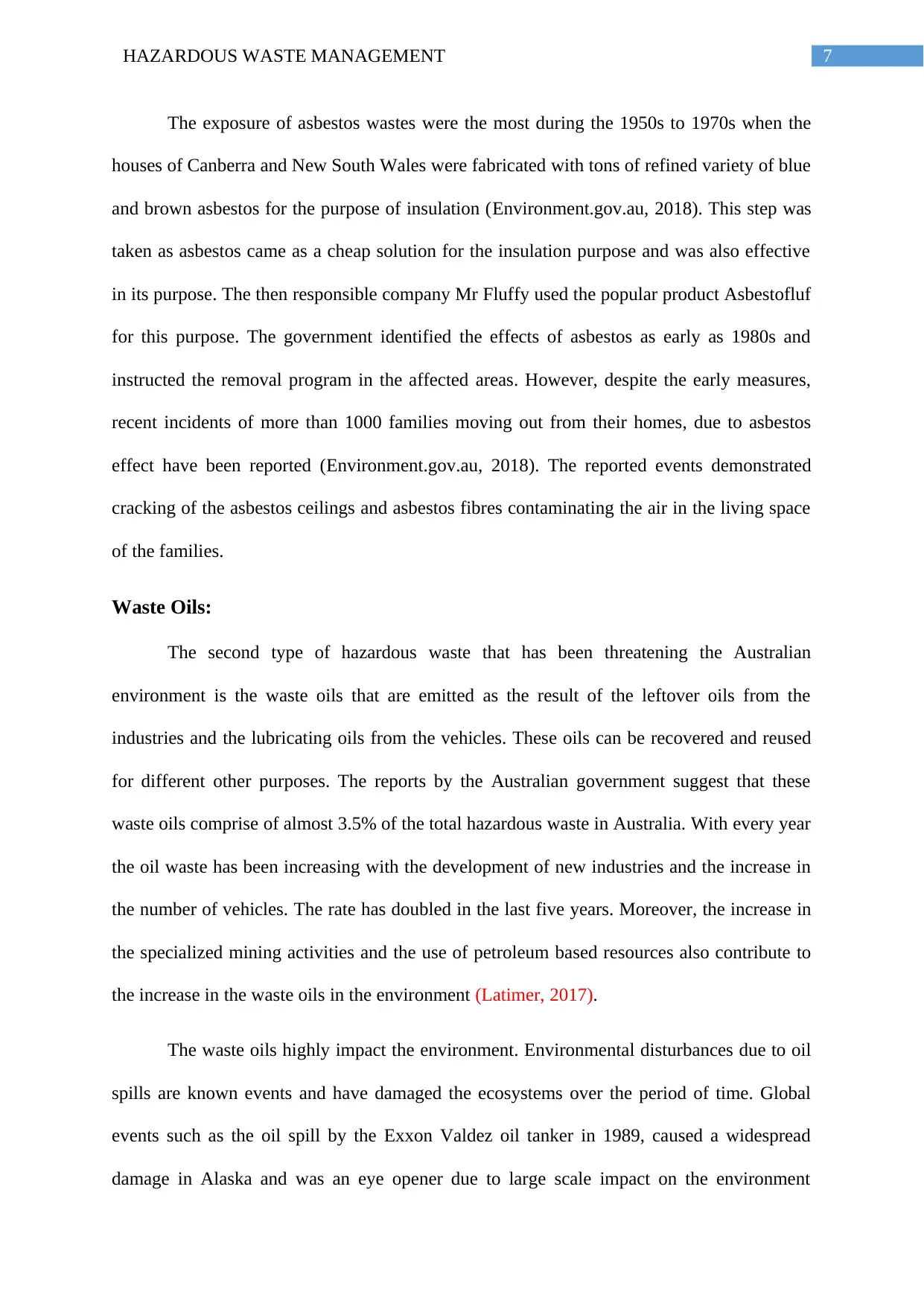
7HAZARDOUS WASTE MANAGEMENT
The exposure of asbestos wastes were the most during the 1950s to 1970s when the
houses of Canberra and New South Wales were fabricated with tons of refined variety of blue
and brown asbestos for the purpose of insulation (Environment.gov.au, 2018). This step was
taken as asbestos came as a cheap solution for the insulation purpose and was also effective
in its purpose. The then responsible company Mr Fluffy used the popular product Asbestofluf
for this purpose. The government identified the effects of asbestos as early as 1980s and
instructed the removal program in the affected areas. However, despite the early measures,
recent incidents of more than 1000 families moving out from their homes, due to asbestos
effect have been reported (Environment.gov.au, 2018). The reported events demonstrated
cracking of the asbestos ceilings and asbestos fibres contaminating the air in the living space
of the families.
Waste Oils:
The second type of hazardous waste that has been threatening the Australian
environment is the waste oils that are emitted as the result of the leftover oils from the
industries and the lubricating oils from the vehicles. These oils can be recovered and reused
for different other purposes. The reports by the Australian government suggest that these
waste oils comprise of almost 3.5% of the total hazardous waste in Australia. With every year
the oil waste has been increasing with the development of new industries and the increase in
the number of vehicles. The rate has doubled in the last five years. Moreover, the increase in
the specialized mining activities and the use of petroleum based resources also contribute to
the increase in the waste oils in the environment (Latimer, 2017).
The waste oils highly impact the environment. Environmental disturbances due to oil
spills are known events and have damaged the ecosystems over the period of time. Global
events such as the oil spill by the Exxon Valdez oil tanker in 1989, caused a widespread
damage in Alaska and was an eye opener due to large scale impact on the environment
The exposure of asbestos wastes were the most during the 1950s to 1970s when the
houses of Canberra and New South Wales were fabricated with tons of refined variety of blue
and brown asbestos for the purpose of insulation (Environment.gov.au, 2018). This step was
taken as asbestos came as a cheap solution for the insulation purpose and was also effective
in its purpose. The then responsible company Mr Fluffy used the popular product Asbestofluf
for this purpose. The government identified the effects of asbestos as early as 1980s and
instructed the removal program in the affected areas. However, despite the early measures,
recent incidents of more than 1000 families moving out from their homes, due to asbestos
effect have been reported (Environment.gov.au, 2018). The reported events demonstrated
cracking of the asbestos ceilings and asbestos fibres contaminating the air in the living space
of the families.
Waste Oils:
The second type of hazardous waste that has been threatening the Australian
environment is the waste oils that are emitted as the result of the leftover oils from the
industries and the lubricating oils from the vehicles. These oils can be recovered and reused
for different other purposes. The reports by the Australian government suggest that these
waste oils comprise of almost 3.5% of the total hazardous waste in Australia. With every year
the oil waste has been increasing with the development of new industries and the increase in
the number of vehicles. The rate has doubled in the last five years. Moreover, the increase in
the specialized mining activities and the use of petroleum based resources also contribute to
the increase in the waste oils in the environment (Latimer, 2017).
The waste oils highly impact the environment. Environmental disturbances due to oil
spills are known events and have damaged the ecosystems over the period of time. Global
events such as the oil spill by the Exxon Valdez oil tanker in 1989, caused a widespread
damage in Alaska and was an eye opener due to large scale impact on the environment
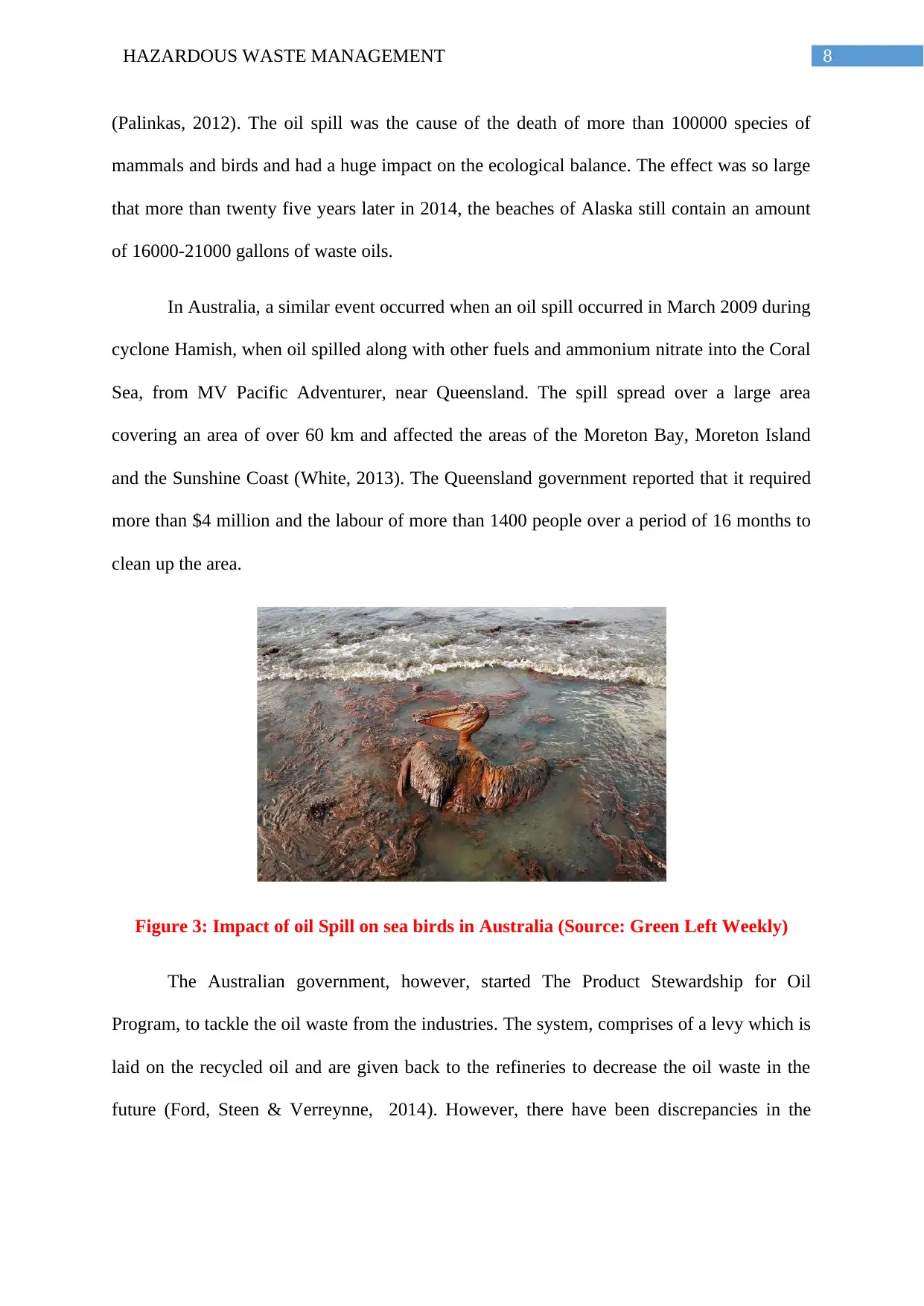
8HAZARDOUS WASTE MANAGEMENT
(Palinkas, 2012). The oil spill was the cause of the death of more than 100000 species of
mammals and birds and had a huge impact on the ecological balance. The effect was so large
that more than twenty five years later in 2014, the beaches of Alaska still contain an amount
of 16000-21000 gallons of waste oils.
In Australia, a similar event occurred when an oil spill occurred in March 2009 during
cyclone Hamish, when oil spilled along with other fuels and ammonium nitrate into the Coral
Sea, from MV Pacific Adventurer, near Queensland. The spill spread over a large area
covering an area of over 60 km and affected the areas of the Moreton Bay, Moreton Island
and the Sunshine Coast (White, 2013). The Queensland government reported that it required
more than $4 million and the labour of more than 1400 people over a period of 16 months to
clean up the area.
Figure 3: Impact of oil Spill on sea birds in Australia (Source: Green Left Weekly)
The Australian government, however, started The Product Stewardship for Oil
Program, to tackle the oil waste from the industries. The system, comprises of a levy which is
laid on the recycled oil and are given back to the refineries to decrease the oil waste in the
future (Ford, Steen & Verreynne, 2014). However, there have been discrepancies in the
(Palinkas, 2012). The oil spill was the cause of the death of more than 100000 species of
mammals and birds and had a huge impact on the ecological balance. The effect was so large
that more than twenty five years later in 2014, the beaches of Alaska still contain an amount
of 16000-21000 gallons of waste oils.
In Australia, a similar event occurred when an oil spill occurred in March 2009 during
cyclone Hamish, when oil spilled along with other fuels and ammonium nitrate into the Coral
Sea, from MV Pacific Adventurer, near Queensland. The spill spread over a large area
covering an area of over 60 km and affected the areas of the Moreton Bay, Moreton Island
and the Sunshine Coast (White, 2013). The Queensland government reported that it required
more than $4 million and the labour of more than 1400 people over a period of 16 months to
clean up the area.
Figure 3: Impact of oil Spill on sea birds in Australia (Source: Green Left Weekly)
The Australian government, however, started The Product Stewardship for Oil
Program, to tackle the oil waste from the industries. The system, comprises of a levy which is
laid on the recycled oil and are given back to the refineries to decrease the oil waste in the
future (Ford, Steen & Verreynne, 2014). However, there have been discrepancies in the
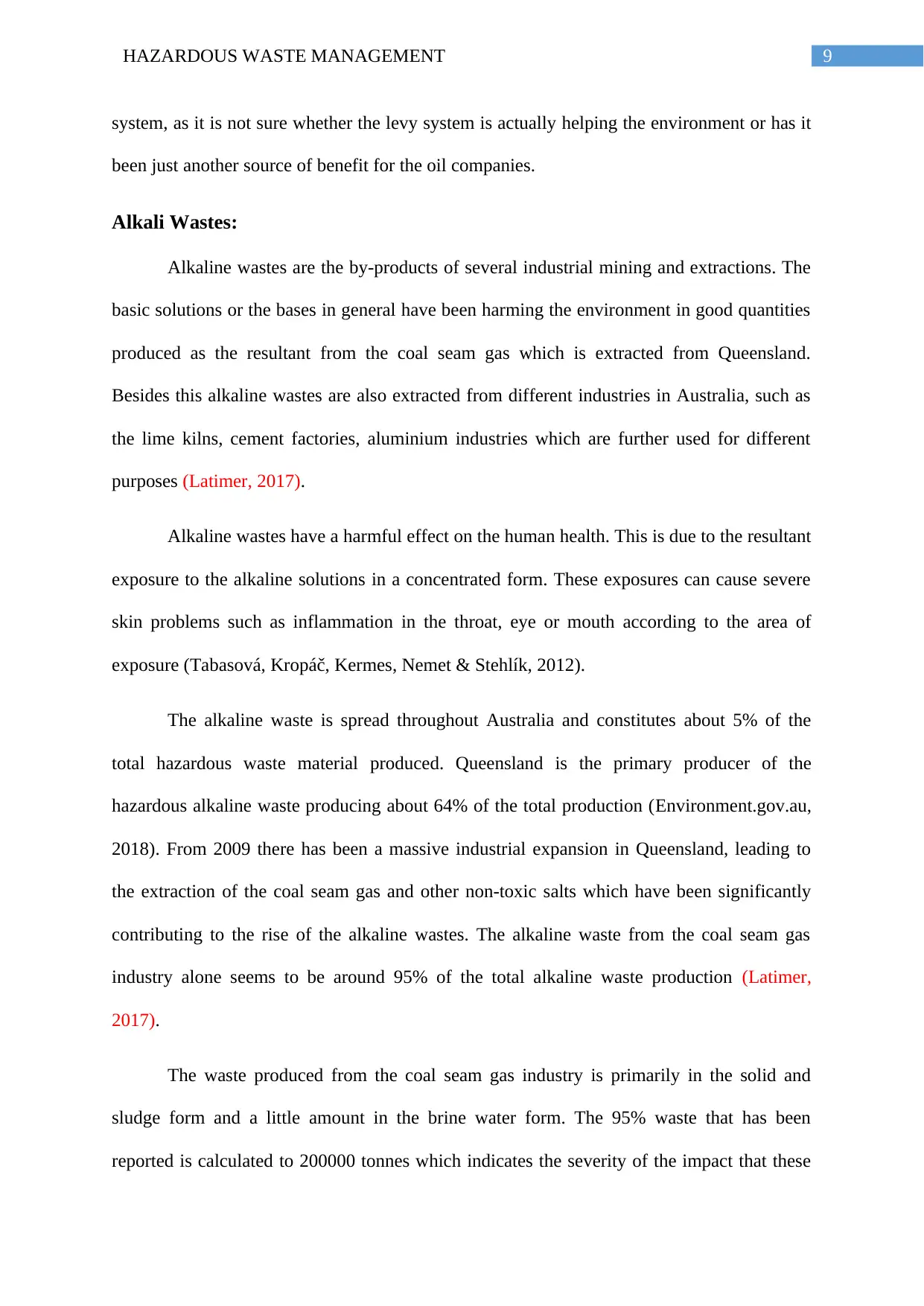
9HAZARDOUS WASTE MANAGEMENT
system, as it is not sure whether the levy system is actually helping the environment or has it
been just another source of benefit for the oil companies.
Alkali Wastes:
Alkaline wastes are the by-products of several industrial mining and extractions. The
basic solutions or the bases in general have been harming the environment in good quantities
produced as the resultant from the coal seam gas which is extracted from Queensland.
Besides this alkaline wastes are also extracted from different industries in Australia, such as
the lime kilns, cement factories, aluminium industries which are further used for different
purposes (Latimer, 2017).
Alkaline wastes have a harmful effect on the human health. This is due to the resultant
exposure to the alkaline solutions in a concentrated form. These exposures can cause severe
skin problems such as inflammation in the throat, eye or mouth according to the area of
exposure (Tabasová, Kropáč, Kermes, Nemet & Stehlík, 2012).
The alkaline waste is spread throughout Australia and constitutes about 5% of the
total hazardous waste material produced. Queensland is the primary producer of the
hazardous alkaline waste producing about 64% of the total production (Environment.gov.au,
2018). From 2009 there has been a massive industrial expansion in Queensland, leading to
the extraction of the coal seam gas and other non-toxic salts which have been significantly
contributing to the rise of the alkaline wastes. The alkaline waste from the coal seam gas
industry alone seems to be around 95% of the total alkaline waste production (Latimer,
2017).
The waste produced from the coal seam gas industry is primarily in the solid and
sludge form and a little amount in the brine water form. The 95% waste that has been
reported is calculated to 200000 tonnes which indicates the severity of the impact that these
system, as it is not sure whether the levy system is actually helping the environment or has it
been just another source of benefit for the oil companies.
Alkali Wastes:
Alkaline wastes are the by-products of several industrial mining and extractions. The
basic solutions or the bases in general have been harming the environment in good quantities
produced as the resultant from the coal seam gas which is extracted from Queensland.
Besides this alkaline wastes are also extracted from different industries in Australia, such as
the lime kilns, cement factories, aluminium industries which are further used for different
purposes (Latimer, 2017).
Alkaline wastes have a harmful effect on the human health. This is due to the resultant
exposure to the alkaline solutions in a concentrated form. These exposures can cause severe
skin problems such as inflammation in the throat, eye or mouth according to the area of
exposure (Tabasová, Kropáč, Kermes, Nemet & Stehlík, 2012).
The alkaline waste is spread throughout Australia and constitutes about 5% of the
total hazardous waste material produced. Queensland is the primary producer of the
hazardous alkaline waste producing about 64% of the total production (Environment.gov.au,
2018). From 2009 there has been a massive industrial expansion in Queensland, leading to
the extraction of the coal seam gas and other non-toxic salts which have been significantly
contributing to the rise of the alkaline wastes. The alkaline waste from the coal seam gas
industry alone seems to be around 95% of the total alkaline waste production (Latimer,
2017).
The waste produced from the coal seam gas industry is primarily in the solid and
sludge form and a little amount in the brine water form. The 95% waste that has been
reported is calculated to 200000 tonnes which indicates the severity of the impact that these
Secure Best Marks with AI Grader
Need help grading? Try our AI Grader for instant feedback on your assignments.
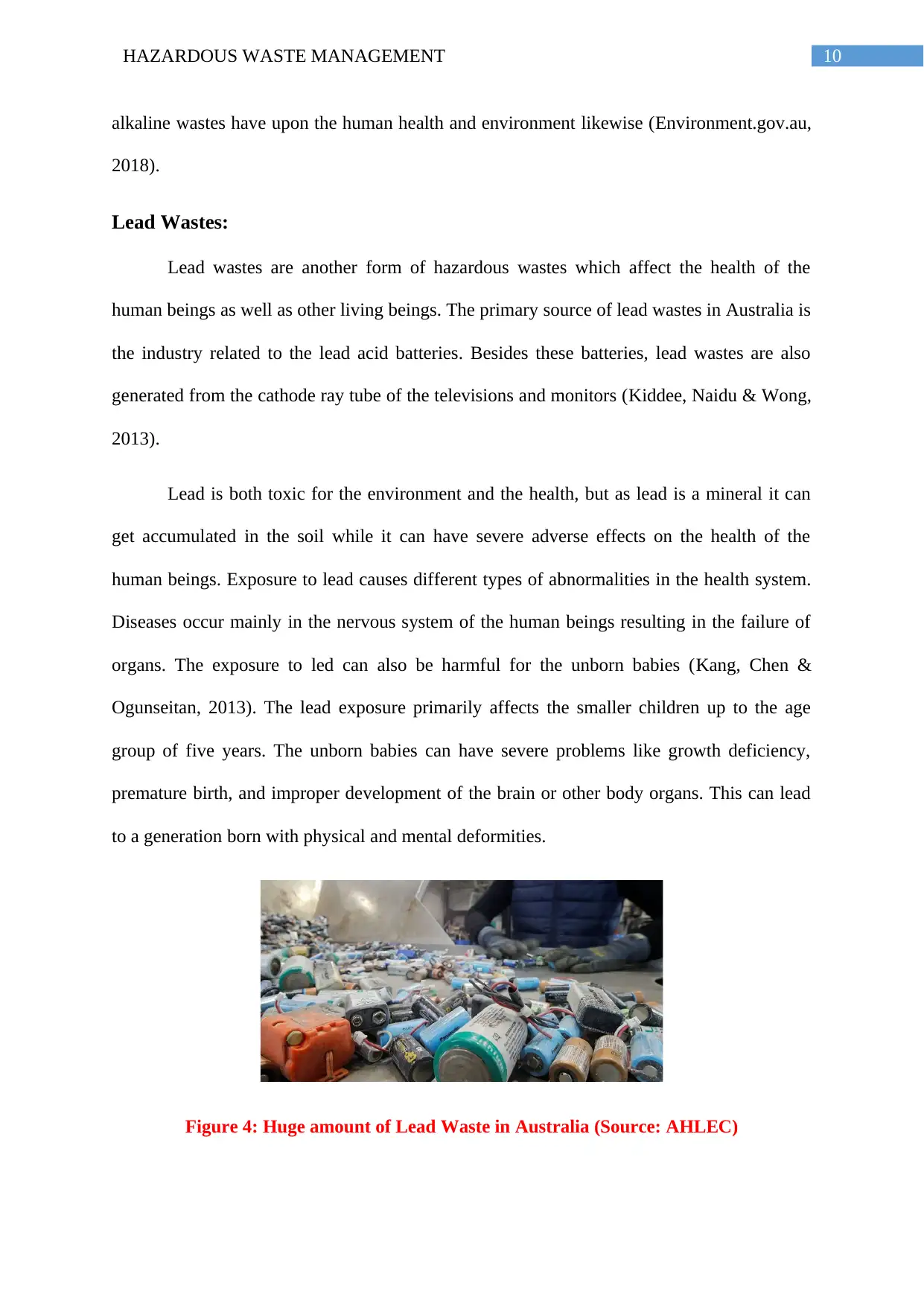
10HAZARDOUS WASTE MANAGEMENT
alkaline wastes have upon the human health and environment likewise (Environment.gov.au,
2018).
Lead Wastes:
Lead wastes are another form of hazardous wastes which affect the health of the
human beings as well as other living beings. The primary source of lead wastes in Australia is
the industry related to the lead acid batteries. Besides these batteries, lead wastes are also
generated from the cathode ray tube of the televisions and monitors (Kiddee, Naidu & Wong,
2013).
Lead is both toxic for the environment and the health, but as lead is a mineral it can
get accumulated in the soil while it can have severe adverse effects on the health of the
human beings. Exposure to lead causes different types of abnormalities in the health system.
Diseases occur mainly in the nervous system of the human beings resulting in the failure of
organs. The exposure to led can also be harmful for the unborn babies (Kang, Chen &
Ogunseitan, 2013). The lead exposure primarily affects the smaller children up to the age
group of five years. The unborn babies can have severe problems like growth deficiency,
premature birth, and improper development of the brain or other body organs. This can lead
to a generation born with physical and mental deformities.
Figure 4: Huge amount of Lead Waste in Australia (Source: AHLEC)
alkaline wastes have upon the human health and environment likewise (Environment.gov.au,
2018).
Lead Wastes:
Lead wastes are another form of hazardous wastes which affect the health of the
human beings as well as other living beings. The primary source of lead wastes in Australia is
the industry related to the lead acid batteries. Besides these batteries, lead wastes are also
generated from the cathode ray tube of the televisions and monitors (Kiddee, Naidu & Wong,
2013).
Lead is both toxic for the environment and the health, but as lead is a mineral it can
get accumulated in the soil while it can have severe adverse effects on the health of the
human beings. Exposure to lead causes different types of abnormalities in the health system.
Diseases occur mainly in the nervous system of the human beings resulting in the failure of
organs. The exposure to led can also be harmful for the unborn babies (Kang, Chen &
Ogunseitan, 2013). The lead exposure primarily affects the smaller children up to the age
group of five years. The unborn babies can have severe problems like growth deficiency,
premature birth, and improper development of the brain or other body organs. This can lead
to a generation born with physical and mental deformities.
Figure 4: Huge amount of Lead Waste in Australia (Source: AHLEC)
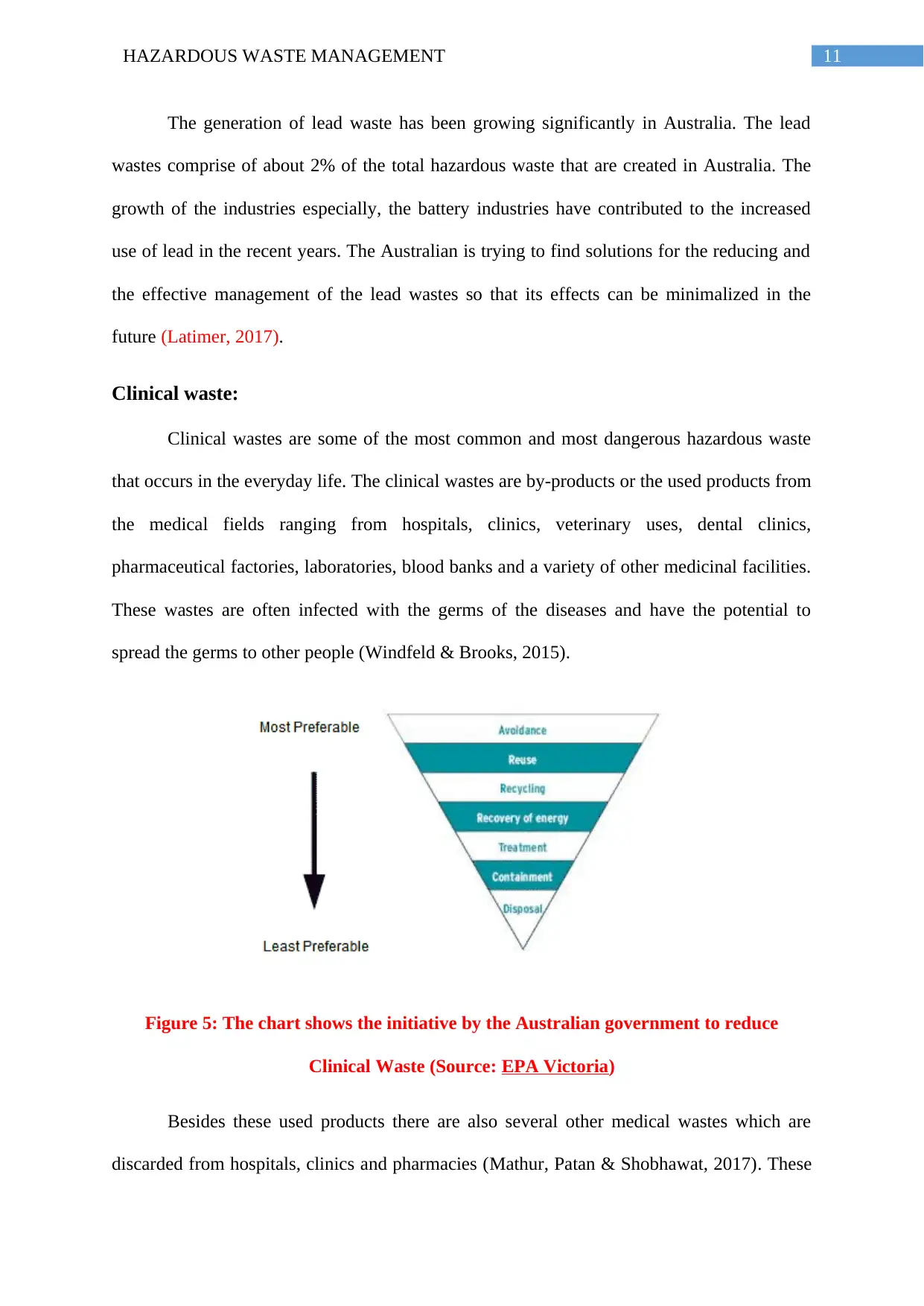
11HAZARDOUS WASTE MANAGEMENT
The generation of lead waste has been growing significantly in Australia. The lead
wastes comprise of about 2% of the total hazardous waste that are created in Australia. The
growth of the industries especially, the battery industries have contributed to the increased
use of lead in the recent years. The Australian is trying to find solutions for the reducing and
the effective management of the lead wastes so that its effects can be minimalized in the
future (Latimer, 2017).
Clinical waste:
Clinical wastes are some of the most common and most dangerous hazardous waste
that occurs in the everyday life. The clinical wastes are by-products or the used products from
the medical fields ranging from hospitals, clinics, veterinary uses, dental clinics,
pharmaceutical factories, laboratories, blood banks and a variety of other medicinal facilities.
These wastes are often infected with the germs of the diseases and have the potential to
spread the germs to other people (Windfeld & Brooks, 2015).
Figure 5: The chart shows the initiative by the Australian government to reduce
Clinical Waste (Source: EPA Victoria)
Besides these used products there are also several other medical wastes which are
discarded from hospitals, clinics and pharmacies (Mathur, Patan & Shobhawat, 2017). These
The generation of lead waste has been growing significantly in Australia. The lead
wastes comprise of about 2% of the total hazardous waste that are created in Australia. The
growth of the industries especially, the battery industries have contributed to the increased
use of lead in the recent years. The Australian is trying to find solutions for the reducing and
the effective management of the lead wastes so that its effects can be minimalized in the
future (Latimer, 2017).
Clinical waste:
Clinical wastes are some of the most common and most dangerous hazardous waste
that occurs in the everyday life. The clinical wastes are by-products or the used products from
the medical fields ranging from hospitals, clinics, veterinary uses, dental clinics,
pharmaceutical factories, laboratories, blood banks and a variety of other medicinal facilities.
These wastes are often infected with the germs of the diseases and have the potential to
spread the germs to other people (Windfeld & Brooks, 2015).
Figure 5: The chart shows the initiative by the Australian government to reduce
Clinical Waste (Source: EPA Victoria)
Besides these used products there are also several other medical wastes which are
discarded from hospitals, clinics and pharmacies (Mathur, Patan & Shobhawat, 2017). These

12HAZARDOUS WASTE MANAGEMENT
products consist of the discarded medicine which have crossed their expiry dates or are
discarded due to non-use. These drugs upon contact with polluted air form several toxic
products which contaminate the environment (British Medical Association, 2013). These
drugs develop cancer-causing agents and highly dangerous if it comes in contact with any
person.
The medical wastes form about 1% of the hazardous wastes in Australia, in terms of
the volume. However, according to the hazard index, these medical wastes are some of the
most dangerous agents to have impact on the environment and human health (García-Pérez et
al., 2013). The dangerous natures of these medical agents are primarily due to the infectious
agents that are present in these wastes. One of the most primary causes of the infection are
the used needles which are a large part of the medical wastes. These wastes contain micro-
organisms of pathogenic nature and can potentially enter the body of any human being by
ingestion or inhalation (Xin, 2015). The most susceptible to these infections are the hospital
staff who are often exposed to accidental piercing from the used needles due to mishandling.
Besides the hazardous factor, the visual impacts of the medical wastes are also disturbing as
they sometimes contain human body parts (Latimer, 2017).
However, Australia maintains a very tight regulation regarding the disposal of
medical wastes, but still poor handling by the hospital staffs and the inefficiency of the health
care facilities in Australia sometimes lead to the improper disposal of the medical wastes
which affect the environment and the human health (Latimer, 2017).
Contaminated Soils:
The contaminated soils are very difficult to study and it is very difficult to judge how
much environmental and health impact they produce. This is due to inability to isolate the
hazardous toxic materials from the soil material. However, it is important to identify the
products consist of the discarded medicine which have crossed their expiry dates or are
discarded due to non-use. These drugs upon contact with polluted air form several toxic
products which contaminate the environment (British Medical Association, 2013). These
drugs develop cancer-causing agents and highly dangerous if it comes in contact with any
person.
The medical wastes form about 1% of the hazardous wastes in Australia, in terms of
the volume. However, according to the hazard index, these medical wastes are some of the
most dangerous agents to have impact on the environment and human health (García-Pérez et
al., 2013). The dangerous natures of these medical agents are primarily due to the infectious
agents that are present in these wastes. One of the most primary causes of the infection are
the used needles which are a large part of the medical wastes. These wastes contain micro-
organisms of pathogenic nature and can potentially enter the body of any human being by
ingestion or inhalation (Xin, 2015). The most susceptible to these infections are the hospital
staff who are often exposed to accidental piercing from the used needles due to mishandling.
Besides the hazardous factor, the visual impacts of the medical wastes are also disturbing as
they sometimes contain human body parts (Latimer, 2017).
However, Australia maintains a very tight regulation regarding the disposal of
medical wastes, but still poor handling by the hospital staffs and the inefficiency of the health
care facilities in Australia sometimes lead to the improper disposal of the medical wastes
which affect the environment and the human health (Latimer, 2017).
Contaminated Soils:
The contaminated soils are very difficult to study and it is very difficult to judge how
much environmental and health impact they produce. This is due to inability to isolate the
hazardous toxic materials from the soil material. However, it is important to identify the
Paraphrase This Document
Need a fresh take? Get an instant paraphrase of this document with our AI Paraphraser
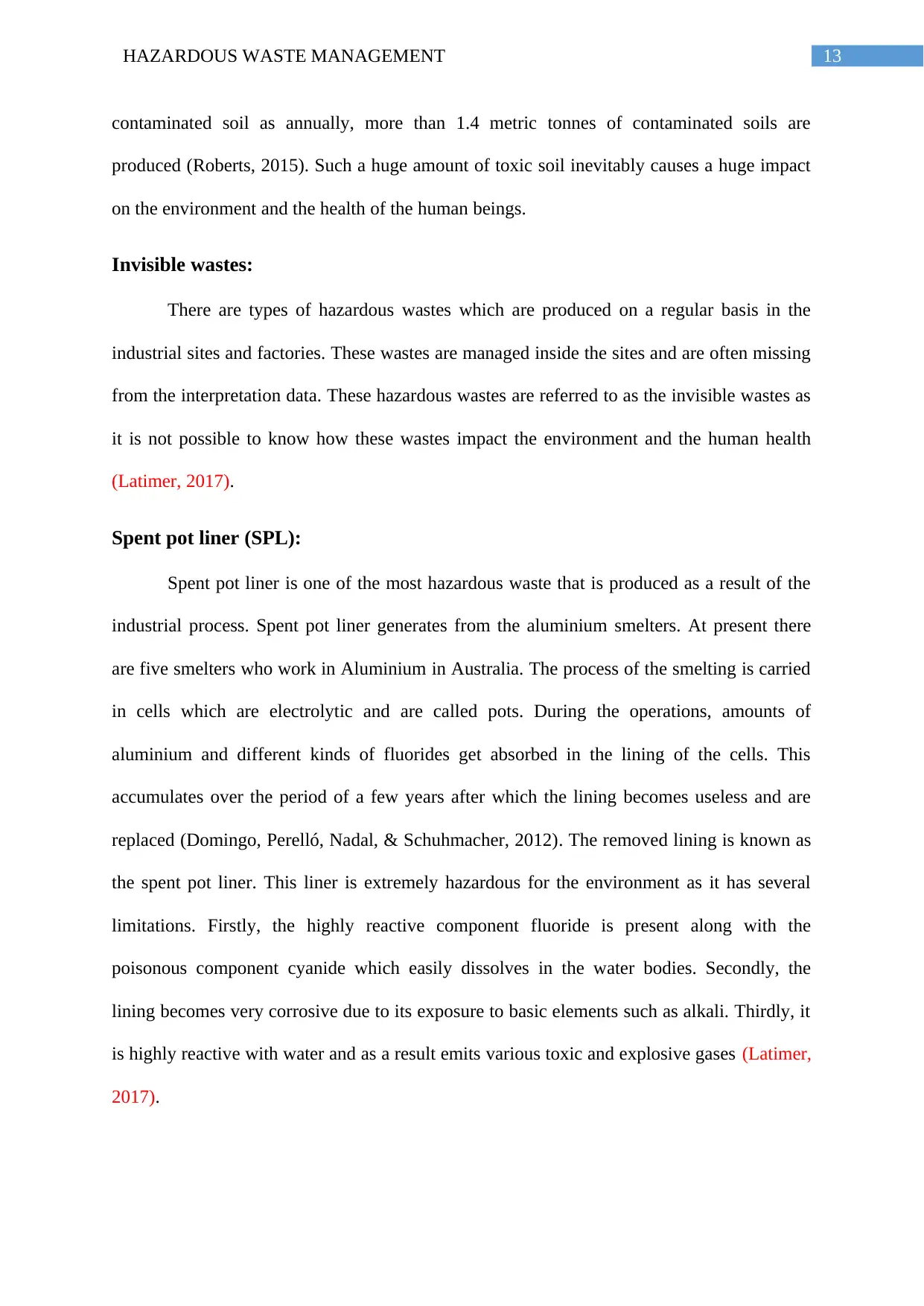
13HAZARDOUS WASTE MANAGEMENT
contaminated soil as annually, more than 1.4 metric tonnes of contaminated soils are
produced (Roberts, 2015). Such a huge amount of toxic soil inevitably causes a huge impact
on the environment and the health of the human beings.
Invisible wastes:
There are types of hazardous wastes which are produced on a regular basis in the
industrial sites and factories. These wastes are managed inside the sites and are often missing
from the interpretation data. These hazardous wastes are referred to as the invisible wastes as
it is not possible to know how these wastes impact the environment and the human health
(Latimer, 2017).
Spent pot liner (SPL):
Spent pot liner is one of the most hazardous waste that is produced as a result of the
industrial process. Spent pot liner generates from the aluminium smelters. At present there
are five smelters who work in Aluminium in Australia. The process of the smelting is carried
in cells which are electrolytic and are called pots. During the operations, amounts of
aluminium and different kinds of fluorides get absorbed in the lining of the cells. This
accumulates over the period of a few years after which the lining becomes useless and are
replaced (Domingo, Perelló, Nadal, & Schuhmacher, 2012). The removed lining is known as
the spent pot liner. This liner is extremely hazardous for the environment as it has several
limitations. Firstly, the highly reactive component fluoride is present along with the
poisonous component cyanide which easily dissolves in the water bodies. Secondly, the
lining becomes very corrosive due to its exposure to basic elements such as alkali. Thirdly, it
is highly reactive with water and as a result emits various toxic and explosive gases (Latimer,
2017).
contaminated soil as annually, more than 1.4 metric tonnes of contaminated soils are
produced (Roberts, 2015). Such a huge amount of toxic soil inevitably causes a huge impact
on the environment and the health of the human beings.
Invisible wastes:
There are types of hazardous wastes which are produced on a regular basis in the
industrial sites and factories. These wastes are managed inside the sites and are often missing
from the interpretation data. These hazardous wastes are referred to as the invisible wastes as
it is not possible to know how these wastes impact the environment and the human health
(Latimer, 2017).
Spent pot liner (SPL):
Spent pot liner is one of the most hazardous waste that is produced as a result of the
industrial process. Spent pot liner generates from the aluminium smelters. At present there
are five smelters who work in Aluminium in Australia. The process of the smelting is carried
in cells which are electrolytic and are called pots. During the operations, amounts of
aluminium and different kinds of fluorides get absorbed in the lining of the cells. This
accumulates over the period of a few years after which the lining becomes useless and are
replaced (Domingo, Perelló, Nadal, & Schuhmacher, 2012). The removed lining is known as
the spent pot liner. This liner is extremely hazardous for the environment as it has several
limitations. Firstly, the highly reactive component fluoride is present along with the
poisonous component cyanide which easily dissolves in the water bodies. Secondly, the
lining becomes very corrosive due to its exposure to basic elements such as alkali. Thirdly, it
is highly reactive with water and as a result emits various toxic and explosive gases (Latimer,
2017).
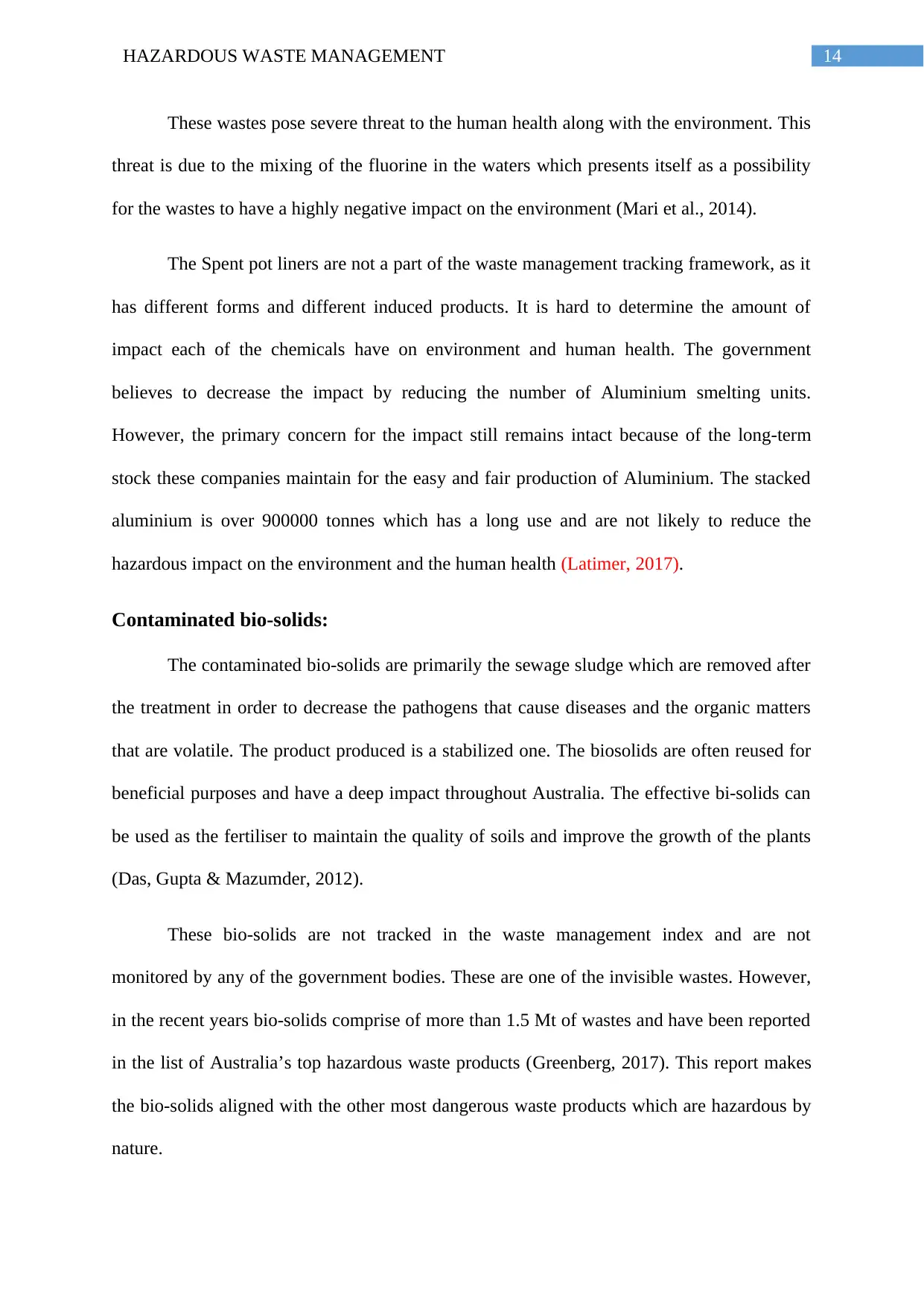
14HAZARDOUS WASTE MANAGEMENT
These wastes pose severe threat to the human health along with the environment. This
threat is due to the mixing of the fluorine in the waters which presents itself as a possibility
for the wastes to have a highly negative impact on the environment (Mari et al., 2014).
The Spent pot liners are not a part of the waste management tracking framework, as it
has different forms and different induced products. It is hard to determine the amount of
impact each of the chemicals have on environment and human health. The government
believes to decrease the impact by reducing the number of Aluminium smelting units.
However, the primary concern for the impact still remains intact because of the long-term
stock these companies maintain for the easy and fair production of Aluminium. The stacked
aluminium is over 900000 tonnes which has a long use and are not likely to reduce the
hazardous impact on the environment and the human health (Latimer, 2017).
Contaminated bio-solids:
The contaminated bio-solids are primarily the sewage sludge which are removed after
the treatment in order to decrease the pathogens that cause diseases and the organic matters
that are volatile. The product produced is a stabilized one. The biosolids are often reused for
beneficial purposes and have a deep impact throughout Australia. The effective bi-solids can
be used as the fertiliser to maintain the quality of soils and improve the growth of the plants
(Das, Gupta & Mazumder, 2012).
These bio-solids are not tracked in the waste management index and are not
monitored by any of the government bodies. These are one of the invisible wastes. However,
in the recent years bio-solids comprise of more than 1.5 Mt of wastes and have been reported
in the list of Australia’s top hazardous waste products (Greenberg, 2017). This report makes
the bio-solids aligned with the other most dangerous waste products which are hazardous by
nature.
These wastes pose severe threat to the human health along with the environment. This
threat is due to the mixing of the fluorine in the waters which presents itself as a possibility
for the wastes to have a highly negative impact on the environment (Mari et al., 2014).
The Spent pot liners are not a part of the waste management tracking framework, as it
has different forms and different induced products. It is hard to determine the amount of
impact each of the chemicals have on environment and human health. The government
believes to decrease the impact by reducing the number of Aluminium smelting units.
However, the primary concern for the impact still remains intact because of the long-term
stock these companies maintain for the easy and fair production of Aluminium. The stacked
aluminium is over 900000 tonnes which has a long use and are not likely to reduce the
hazardous impact on the environment and the human health (Latimer, 2017).
Contaminated bio-solids:
The contaminated bio-solids are primarily the sewage sludge which are removed after
the treatment in order to decrease the pathogens that cause diseases and the organic matters
that are volatile. The product produced is a stabilized one. The biosolids are often reused for
beneficial purposes and have a deep impact throughout Australia. The effective bi-solids can
be used as the fertiliser to maintain the quality of soils and improve the growth of the plants
(Das, Gupta & Mazumder, 2012).
These bio-solids are not tracked in the waste management index and are not
monitored by any of the government bodies. These are one of the invisible wastes. However,
in the recent years bio-solids comprise of more than 1.5 Mt of wastes and have been reported
in the list of Australia’s top hazardous waste products (Greenberg, 2017). This report makes
the bio-solids aligned with the other most dangerous waste products which are hazardous by
nature.

15HAZARDOUS WASTE MANAGEMENT
Bio-solids are generally not considered as hazardous wastes, however, the bio-solids
which are generated from the industrial areas are generally contaminated with different
industrial wastes such as heavy metals and other contaminating agents that exceed the
marking criteria set for the protection of the environment and the human health (Lu, Chang &
Liao, 2013). This type of classification categorizes bio-solids in the hazardous waste list.
It is to be noted that there are two types of bio-solids, one categorized as hazardous
due to its generation in the industrial area and the other one being beneficial towards
increasing the soil quality. From the reports by the government bodies it is observed that on
the basis of the waste management, most of the bio-solids exceed the level of the hazardous
index and comprises of the hazardous chemicals and toxins which make it more dangerous
towards the environment (Chandrappa & Das, 2012). The presence of arsenic, mercury and
lead in the bio-solids establish the fact that the bio-solids have crossed the threshold of the
hazardous waste and are susceptible to have a deep impact on the environment.
This discovery of bio-solids being a hazardous waste is a recent development and has
caused much awareness among the community. However, at this initial stage the government
can take appropriate measures to track down the limit of hazard that can avoided from the
bio-solids. These can create an extensive bio-solids management system and can effectively
reduce the impact of the bio-solids upon the environment (Latimer, 2017).
Coal Seam Gas waste:
As has been discussed earlier the largest production of coal seam gas occurs in
Queensland. A few units can also be found in the New South Wales. The coal seam gas waste
products consist of 80% of the waste products that are produced in Queensland. These waste
materials are monitored and categorised by the government so as identify the intensity of
their hazardousness (Latimer, 2017).
Bio-solids are generally not considered as hazardous wastes, however, the bio-solids
which are generated from the industrial areas are generally contaminated with different
industrial wastes such as heavy metals and other contaminating agents that exceed the
marking criteria set for the protection of the environment and the human health (Lu, Chang &
Liao, 2013). This type of classification categorizes bio-solids in the hazardous waste list.
It is to be noted that there are two types of bio-solids, one categorized as hazardous
due to its generation in the industrial area and the other one being beneficial towards
increasing the soil quality. From the reports by the government bodies it is observed that on
the basis of the waste management, most of the bio-solids exceed the level of the hazardous
index and comprises of the hazardous chemicals and toxins which make it more dangerous
towards the environment (Chandrappa & Das, 2012). The presence of arsenic, mercury and
lead in the bio-solids establish the fact that the bio-solids have crossed the threshold of the
hazardous waste and are susceptible to have a deep impact on the environment.
This discovery of bio-solids being a hazardous waste is a recent development and has
caused much awareness among the community. However, at this initial stage the government
can take appropriate measures to track down the limit of hazard that can avoided from the
bio-solids. These can create an extensive bio-solids management system and can effectively
reduce the impact of the bio-solids upon the environment (Latimer, 2017).
Coal Seam Gas waste:
As has been discussed earlier the largest production of coal seam gas occurs in
Queensland. A few units can also be found in the New South Wales. The coal seam gas waste
products consist of 80% of the waste products that are produced in Queensland. These waste
materials are monitored and categorised by the government so as identify the intensity of
their hazardousness (Latimer, 2017).
Secure Best Marks with AI Grader
Need help grading? Try our AI Grader for instant feedback on your assignments.
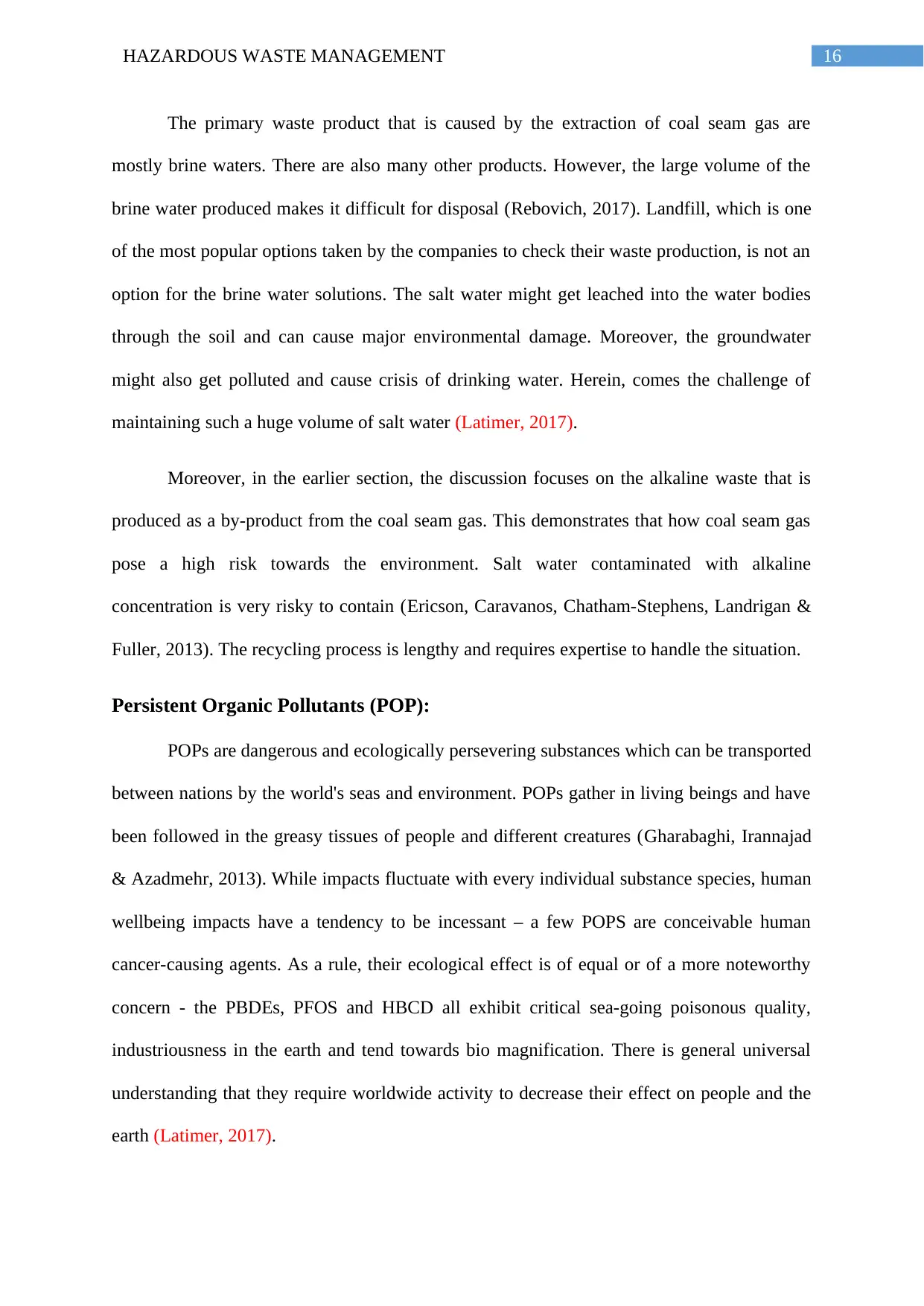
16HAZARDOUS WASTE MANAGEMENT
The primary waste product that is caused by the extraction of coal seam gas are
mostly brine waters. There are also many other products. However, the large volume of the
brine water produced makes it difficult for disposal (Rebovich, 2017). Landfill, which is one
of the most popular options taken by the companies to check their waste production, is not an
option for the brine water solutions. The salt water might get leached into the water bodies
through the soil and can cause major environmental damage. Moreover, the groundwater
might also get polluted and cause crisis of drinking water. Herein, comes the challenge of
maintaining such a huge volume of salt water (Latimer, 2017).
Moreover, in the earlier section, the discussion focuses on the alkaline waste that is
produced as a by-product from the coal seam gas. This demonstrates that how coal seam gas
pose a high risk towards the environment. Salt water contaminated with alkaline
concentration is very risky to contain (Ericson, Caravanos, Chatham-Stephens, Landrigan &
Fuller, 2013). The recycling process is lengthy and requires expertise to handle the situation.
Persistent Organic Pollutants (POP):
POPs are dangerous and ecologically persevering substances which can be transported
between nations by the world's seas and environment. POPs gather in living beings and have
been followed in the greasy tissues of people and different creatures (Gharabaghi, Irannajad
& Azadmehr, 2013). While impacts fluctuate with every individual substance species, human
wellbeing impacts have a tendency to be incessant – a few POPS are conceivable human
cancer-causing agents. As a rule, their ecological effect is of equal or of a more noteworthy
concern - the PBDEs, PFOS and HBCD all exhibit critical sea-going poisonous quality,
industriousness in the earth and tend towards bio magnification. There is general universal
understanding that they require worldwide activity to decrease their effect on people and the
earth (Latimer, 2017).
The primary waste product that is caused by the extraction of coal seam gas are
mostly brine waters. There are also many other products. However, the large volume of the
brine water produced makes it difficult for disposal (Rebovich, 2017). Landfill, which is one
of the most popular options taken by the companies to check their waste production, is not an
option for the brine water solutions. The salt water might get leached into the water bodies
through the soil and can cause major environmental damage. Moreover, the groundwater
might also get polluted and cause crisis of drinking water. Herein, comes the challenge of
maintaining such a huge volume of salt water (Latimer, 2017).
Moreover, in the earlier section, the discussion focuses on the alkaline waste that is
produced as a by-product from the coal seam gas. This demonstrates that how coal seam gas
pose a high risk towards the environment. Salt water contaminated with alkaline
concentration is very risky to contain (Ericson, Caravanos, Chatham-Stephens, Landrigan &
Fuller, 2013). The recycling process is lengthy and requires expertise to handle the situation.
Persistent Organic Pollutants (POP):
POPs are dangerous and ecologically persevering substances which can be transported
between nations by the world's seas and environment. POPs gather in living beings and have
been followed in the greasy tissues of people and different creatures (Gharabaghi, Irannajad
& Azadmehr, 2013). While impacts fluctuate with every individual substance species, human
wellbeing impacts have a tendency to be incessant – a few POPS are conceivable human
cancer-causing agents. As a rule, their ecological effect is of equal or of a more noteworthy
concern - the PBDEs, PFOS and HBCD all exhibit critical sea-going poisonous quality,
industriousness in the earth and tend towards bio magnification. There is general universal
understanding that they require worldwide activity to decrease their effect on people and the
earth (Latimer, 2017).
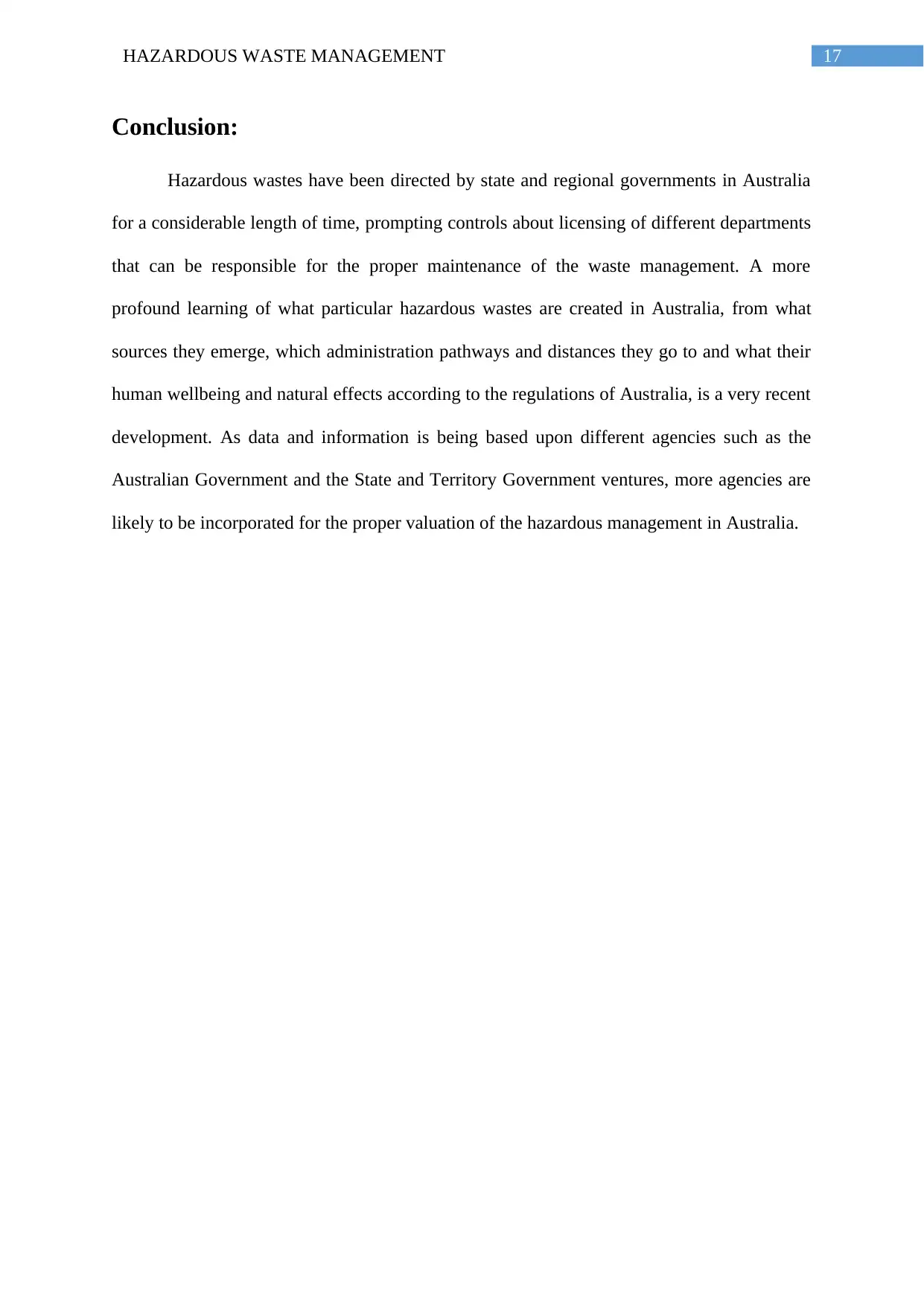
17HAZARDOUS WASTE MANAGEMENT
Conclusion:
Hazardous wastes have been directed by state and regional governments in Australia
for a considerable length of time, prompting controls about licensing of different departments
that can be responsible for the proper maintenance of the waste management. A more
profound learning of what particular hazardous wastes are created in Australia, from what
sources they emerge, which administration pathways and distances they go to and what their
human wellbeing and natural effects according to the regulations of Australia, is a very recent
development. As data and information is being based upon different agencies such as the
Australian Government and the State and Territory Government ventures, more agencies are
likely to be incorporated for the proper valuation of the hazardous management in Australia.
Conclusion:
Hazardous wastes have been directed by state and regional governments in Australia
for a considerable length of time, prompting controls about licensing of different departments
that can be responsible for the proper maintenance of the waste management. A more
profound learning of what particular hazardous wastes are created in Australia, from what
sources they emerge, which administration pathways and distances they go to and what their
human wellbeing and natural effects according to the regulations of Australia, is a very recent
development. As data and information is being based upon different agencies such as the
Australian Government and the State and Territory Government ventures, more agencies are
likely to be incorporated for the proper valuation of the hazardous management in Australia.
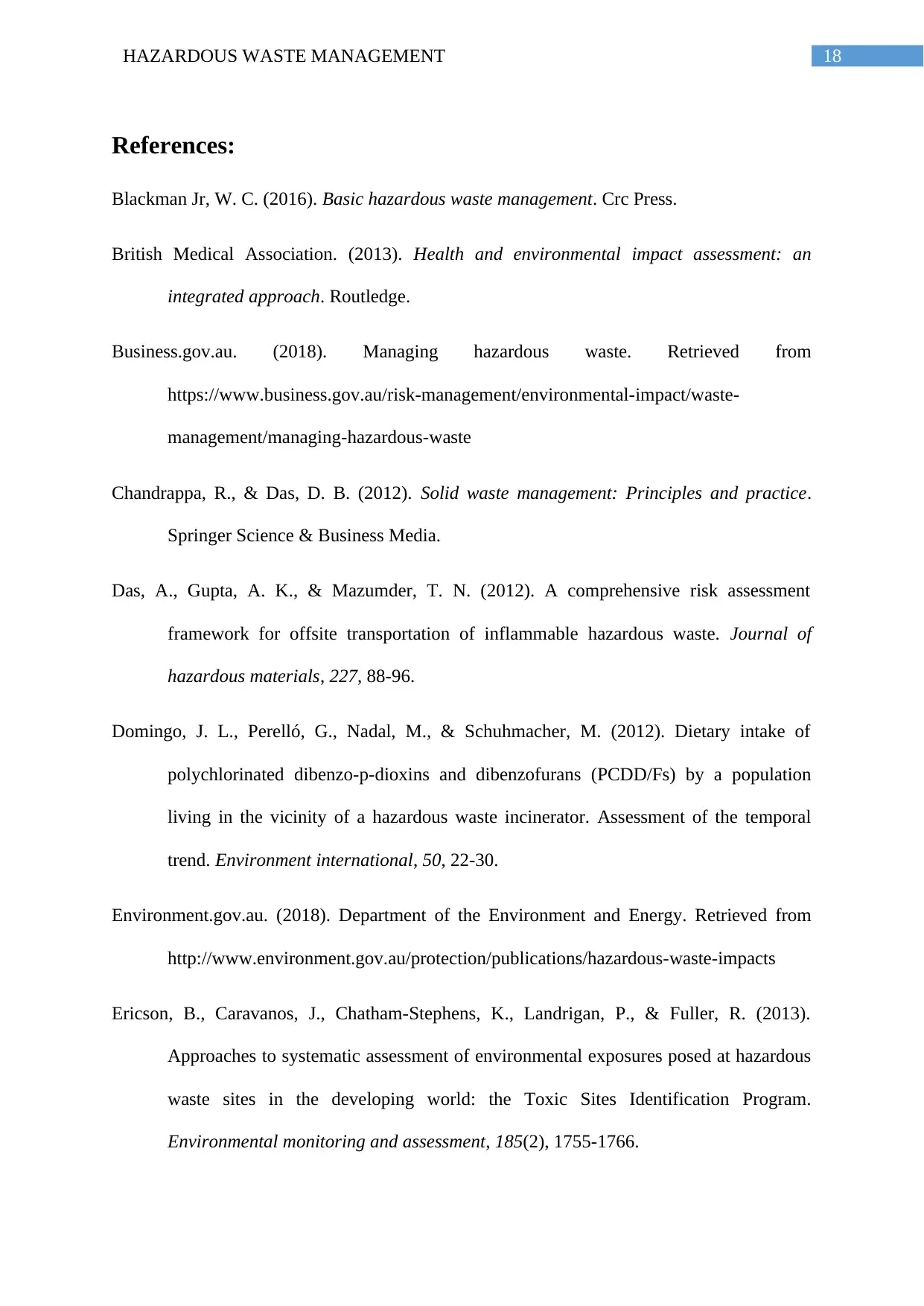
18HAZARDOUS WASTE MANAGEMENT
References:
Blackman Jr, W. C. (2016). Basic hazardous waste management. Crc Press.
British Medical Association. (2013). Health and environmental impact assessment: an
integrated approach. Routledge.
Business.gov.au. (2018). Managing hazardous waste. Retrieved from
https://www.business.gov.au/risk-management/environmental-impact/waste-
management/managing-hazardous-waste
Chandrappa, R., & Das, D. B. (2012). Solid waste management: Principles and practice.
Springer Science & Business Media.
Das, A., Gupta, A. K., & Mazumder, T. N. (2012). A comprehensive risk assessment
framework for offsite transportation of inflammable hazardous waste. Journal of
hazardous materials, 227, 88-96.
Domingo, J. L., Perelló, G., Nadal, M., & Schuhmacher, M. (2012). Dietary intake of
polychlorinated dibenzo-p-dioxins and dibenzofurans (PCDD/Fs) by a population
living in the vicinity of a hazardous waste incinerator. Assessment of the temporal
trend. Environment international, 50, 22-30.
Environment.gov.au. (2018). Department of the Environment and Energy. Retrieved from
http://www.environment.gov.au/protection/publications/hazardous-waste-impacts
Ericson, B., Caravanos, J., Chatham-Stephens, K., Landrigan, P., & Fuller, R. (2013).
Approaches to systematic assessment of environmental exposures posed at hazardous
waste sites in the developing world: the Toxic Sites Identification Program.
Environmental monitoring and assessment, 185(2), 1755-1766.
References:
Blackman Jr, W. C. (2016). Basic hazardous waste management. Crc Press.
British Medical Association. (2013). Health and environmental impact assessment: an
integrated approach. Routledge.
Business.gov.au. (2018). Managing hazardous waste. Retrieved from
https://www.business.gov.au/risk-management/environmental-impact/waste-
management/managing-hazardous-waste
Chandrappa, R., & Das, D. B. (2012). Solid waste management: Principles and practice.
Springer Science & Business Media.
Das, A., Gupta, A. K., & Mazumder, T. N. (2012). A comprehensive risk assessment
framework for offsite transportation of inflammable hazardous waste. Journal of
hazardous materials, 227, 88-96.
Domingo, J. L., Perelló, G., Nadal, M., & Schuhmacher, M. (2012). Dietary intake of
polychlorinated dibenzo-p-dioxins and dibenzofurans (PCDD/Fs) by a population
living in the vicinity of a hazardous waste incinerator. Assessment of the temporal
trend. Environment international, 50, 22-30.
Environment.gov.au. (2018). Department of the Environment and Energy. Retrieved from
http://www.environment.gov.au/protection/publications/hazardous-waste-impacts
Ericson, B., Caravanos, J., Chatham-Stephens, K., Landrigan, P., & Fuller, R. (2013).
Approaches to systematic assessment of environmental exposures posed at hazardous
waste sites in the developing world: the Toxic Sites Identification Program.
Environmental monitoring and assessment, 185(2), 1755-1766.
Paraphrase This Document
Need a fresh take? Get an instant paraphrase of this document with our AI Paraphraser

19HAZARDOUS WASTE MANAGEMENT
Ford, J. A., Steen, J., & Verreynne, M. L. (2014). How environmental regulations affect
innovation in the Australian oil and gas industry: going beyond the Porter Hypothesis.
Journal of Cleaner Production, 84, 204-213.
Gamper-Rabindran, S., & Timmins, C. (2013). Does cleanup of hazardous waste sites raise
housing values? Evidence of spatially localized benefits. Journal of Environmental
Economics and Management, 65(3), 345-360.
García-Pérez, J., Fernández-Navarro, P., Castelló, A., López-Cima, M. F., Ramis, R., Boldo,
E., & López-Abente, G. (2013). Cancer mortality in towns in the vicinity of
incinerators and installations for the recovery or disposal of hazardous waste.
Environment international, 51, 31-44.
Gharabaghi, M., Irannajad, M., & Azadmehr, A. R. (2013). Leaching kinetics of nickel
extraction from hazardous waste by sulphuric acid and optimization dissolution
conditions. Chemical Engineering Research and Design, 91(2), 325-331.
Greenberg, M. R. (2017). Hazardous waste sites: The credibility gap. Routledge.
Guerrero, L. A., Maas, G., & Hogland, W. (2013). Solid waste management challenges for
cities in developing countries. Waste management, 33(1), 220-232.
Hoornweg, D., & Bhada-Tata, P. (2012). What a waste: a global review of solid waste
management.
Inglezakis, V. J., & Moustakas, K. (2015). Household hazardous waste management: A
review. Journal of environmental management, 150, 310-321.
Kang, D. H. P., Chen, M., & Ogunseitan, O. A. (2013). Potential environmental and human
health impacts of rechargeable lithium batteries in electronic waste. Environmental
science & technology, 47(10), 5495-5503.
Ford, J. A., Steen, J., & Verreynne, M. L. (2014). How environmental regulations affect
innovation in the Australian oil and gas industry: going beyond the Porter Hypothesis.
Journal of Cleaner Production, 84, 204-213.
Gamper-Rabindran, S., & Timmins, C. (2013). Does cleanup of hazardous waste sites raise
housing values? Evidence of spatially localized benefits. Journal of Environmental
Economics and Management, 65(3), 345-360.
García-Pérez, J., Fernández-Navarro, P., Castelló, A., López-Cima, M. F., Ramis, R., Boldo,
E., & López-Abente, G. (2013). Cancer mortality in towns in the vicinity of
incinerators and installations for the recovery or disposal of hazardous waste.
Environment international, 51, 31-44.
Gharabaghi, M., Irannajad, M., & Azadmehr, A. R. (2013). Leaching kinetics of nickel
extraction from hazardous waste by sulphuric acid and optimization dissolution
conditions. Chemical Engineering Research and Design, 91(2), 325-331.
Greenberg, M. R. (2017). Hazardous waste sites: The credibility gap. Routledge.
Guerrero, L. A., Maas, G., & Hogland, W. (2013). Solid waste management challenges for
cities in developing countries. Waste management, 33(1), 220-232.
Hoornweg, D., & Bhada-Tata, P. (2012). What a waste: a global review of solid waste
management.
Inglezakis, V. J., & Moustakas, K. (2015). Household hazardous waste management: A
review. Journal of environmental management, 150, 310-321.
Kang, D. H. P., Chen, M., & Ogunseitan, O. A. (2013). Potential environmental and human
health impacts of rechargeable lithium batteries in electronic waste. Environmental
science & technology, 47(10), 5495-5503.

20HAZARDOUS WASTE MANAGEMENT
Khaliq, A., Rhamdhani, M. A., Brooks, G., & Masood, S. (2014). Metal extraction processes
for electronic waste and existing industrial routes: a review and Australian
perspective. Resources, 3(1), 152-179.
Kiddee, P., Naidu, R., & Wong, M. H. (2013). Electronic waste management approaches: An
overview. Waste Management, 33(5), 1237-1250.
Latimer, G. (2017). Retrieved from
http://www.environment.gov.au/system/files/resources/9ae68d42-d52e-4b1d-9008-
111ad8bacfea/files/hazardous-waste-australia.pdf
Lu, J. W., Chang, N. B., & Liao, L. (2013). Environmental informatics for solid and
hazardous waste management: advances, challenges, and perspectives. Critical
reviews in environmental science and technology, 43(15), 1557-1656.
Mari, M., Nadal, M., Schuhmacher, M., Barbería, E., García, F., & Domingo, J. L. (2014).
Human exposure to metals: levels in autopsy tissues of individuals living near a
hazardous waste incinerator. Biological trace element research, 159(1-3), 15-21.
Mathur, P., Patan, S., & Shobhawat, A. S. (2017). Need of biomedical waste management
system in hospitals-An emerging issue-a review. Current World Environment, 7(1).
Palinkas, L. A. (2012). A conceptual framework for understanding the mental health impacts
of oil spills: lessons from the Exxon Valdez oil spill. Psychiatry: Interpersonal &
Biological Processes, 75(3), 203-222.
Rebovich, D. J. (2017). Dangerous ground: the world of hazardous waste crime. Routledge.
Roberts, D. (2015). Characterisation of chemical composition and energy content of green
waste and municipal solid waste from Greater Brisbane, Australia. Waste
management, 41, 12-19.
Khaliq, A., Rhamdhani, M. A., Brooks, G., & Masood, S. (2014). Metal extraction processes
for electronic waste and existing industrial routes: a review and Australian
perspective. Resources, 3(1), 152-179.
Kiddee, P., Naidu, R., & Wong, M. H. (2013). Electronic waste management approaches: An
overview. Waste Management, 33(5), 1237-1250.
Latimer, G. (2017). Retrieved from
http://www.environment.gov.au/system/files/resources/9ae68d42-d52e-4b1d-9008-
111ad8bacfea/files/hazardous-waste-australia.pdf
Lu, J. W., Chang, N. B., & Liao, L. (2013). Environmental informatics for solid and
hazardous waste management: advances, challenges, and perspectives. Critical
reviews in environmental science and technology, 43(15), 1557-1656.
Mari, M., Nadal, M., Schuhmacher, M., Barbería, E., García, F., & Domingo, J. L. (2014).
Human exposure to metals: levels in autopsy tissues of individuals living near a
hazardous waste incinerator. Biological trace element research, 159(1-3), 15-21.
Mathur, P., Patan, S., & Shobhawat, A. S. (2017). Need of biomedical waste management
system in hospitals-An emerging issue-a review. Current World Environment, 7(1).
Palinkas, L. A. (2012). A conceptual framework for understanding the mental health impacts
of oil spills: lessons from the Exxon Valdez oil spill. Psychiatry: Interpersonal &
Biological Processes, 75(3), 203-222.
Rebovich, D. J. (2017). Dangerous ground: the world of hazardous waste crime. Routledge.
Roberts, D. (2015). Characterisation of chemical composition and energy content of green
waste and municipal solid waste from Greater Brisbane, Australia. Waste
management, 41, 12-19.
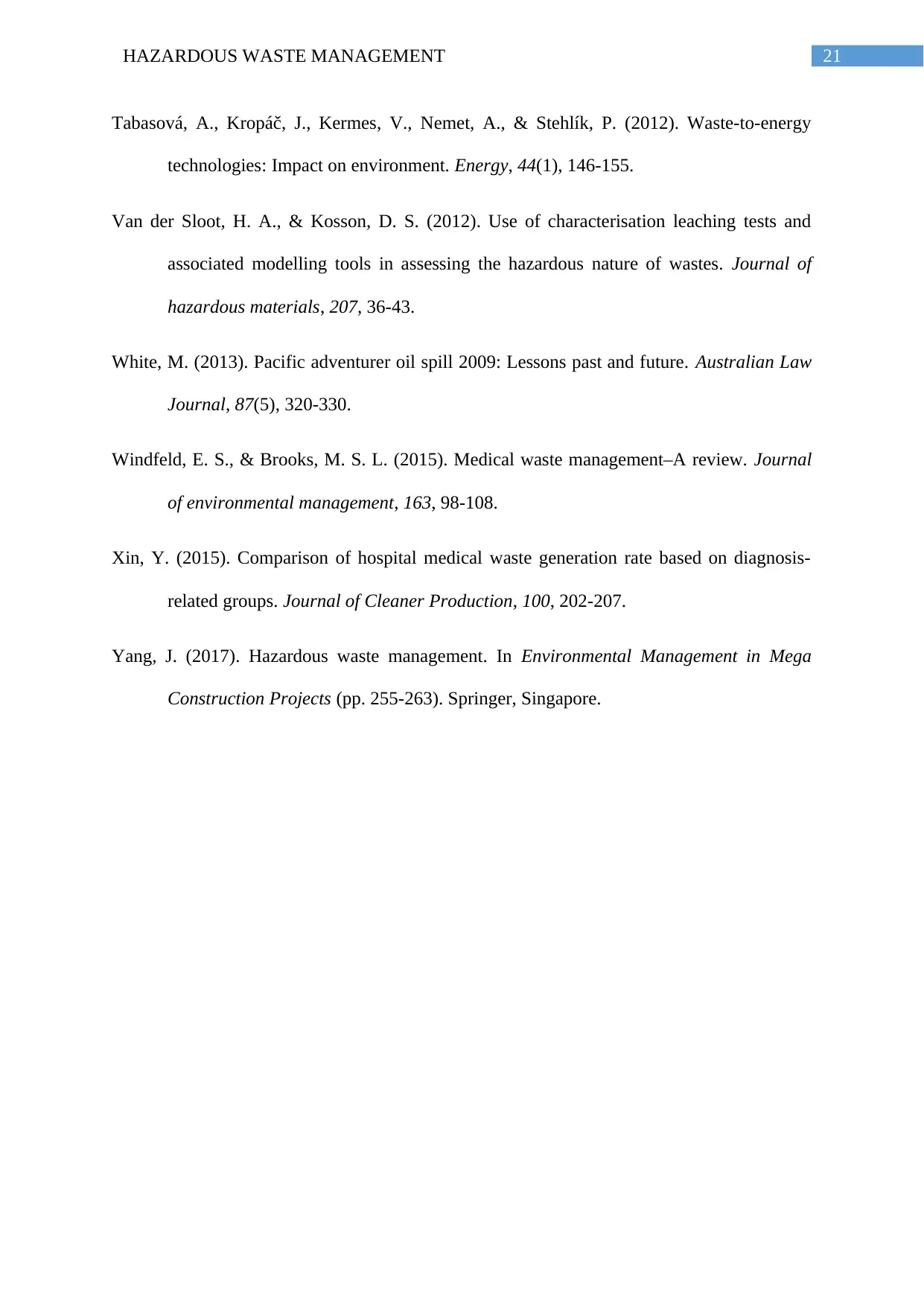
21HAZARDOUS WASTE MANAGEMENT
Tabasová, A., Kropáč, J., Kermes, V., Nemet, A., & Stehlík, P. (2012). Waste-to-energy
technologies: Impact on environment. Energy, 44(1), 146-155.
Van der Sloot, H. A., & Kosson, D. S. (2012). Use of characterisation leaching tests and
associated modelling tools in assessing the hazardous nature of wastes. Journal of
hazardous materials, 207, 36-43.
White, M. (2013). Pacific adventurer oil spill 2009: Lessons past and future. Australian Law
Journal, 87(5), 320-330.
Windfeld, E. S., & Brooks, M. S. L. (2015). Medical waste management–A review. Journal
of environmental management, 163, 98-108.
Xin, Y. (2015). Comparison of hospital medical waste generation rate based on diagnosis-
related groups. Journal of Cleaner Production, 100, 202-207.
Yang, J. (2017). Hazardous waste management. In Environmental Management in Mega
Construction Projects (pp. 255-263). Springer, Singapore.
Tabasová, A., Kropáč, J., Kermes, V., Nemet, A., & Stehlík, P. (2012). Waste-to-energy
technologies: Impact on environment. Energy, 44(1), 146-155.
Van der Sloot, H. A., & Kosson, D. S. (2012). Use of characterisation leaching tests and
associated modelling tools in assessing the hazardous nature of wastes. Journal of
hazardous materials, 207, 36-43.
White, M. (2013). Pacific adventurer oil spill 2009: Lessons past and future. Australian Law
Journal, 87(5), 320-330.
Windfeld, E. S., & Brooks, M. S. L. (2015). Medical waste management–A review. Journal
of environmental management, 163, 98-108.
Xin, Y. (2015). Comparison of hospital medical waste generation rate based on diagnosis-
related groups. Journal of Cleaner Production, 100, 202-207.
Yang, J. (2017). Hazardous waste management. In Environmental Management in Mega
Construction Projects (pp. 255-263). Springer, Singapore.
1 out of 22
Related Documents
Your All-in-One AI-Powered Toolkit for Academic Success.
+13062052269
info@desklib.com
Available 24*7 on WhatsApp / Email
![[object Object]](/_next/static/media/star-bottom.7253800d.svg)
Unlock your academic potential
© 2024 | Zucol Services PVT LTD | All rights reserved.





